

|
 |
Bride of Re-Animator AKA Re-Animator 2 (Blu-ray)
[Blu-ray]
Blu-ray ALL - United Kingdom - Arrow Films Review written by and copyright: Paul Lewis (10th April 2016). |
|
The Film
 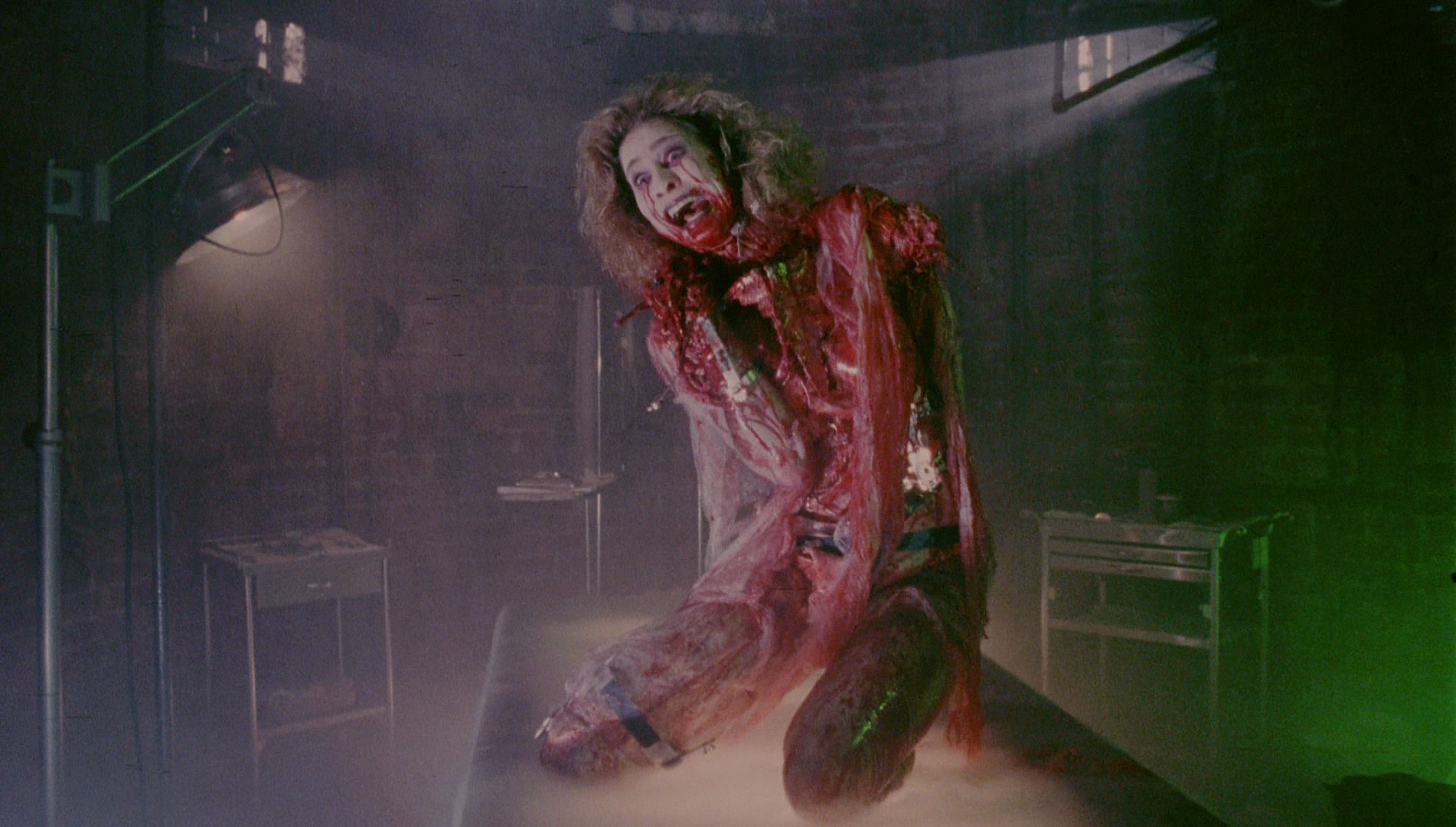 Bride of Re-Animator (Brian Yuzna, 1990) Bride of Re-Animator (Brian Yuzna, 1990)
A sequel to Stuart Gordon’s shocking, ironic and excessive H P Lovecraft adaptation Re-Animator (1985), Bride of Re-Animator (1989) was directed by Brian Yuzna, the producer of Gordon’s film. As the title suggests, the picture is to some extent a self-aware pastiche of earlier horror films – in particular, James Whale’s Bride of Frankenstein (1935). Like Whale’s film, Bride of Re-Animator demonstrates a camp extravagance and playfulness, an ironic approach to the paradigms of the horror film and oodles of black humour. Eight months after the events of Re-Animator, Doctors Herbert West (Jeffrey Combs) and Dan Cain (Bruce Abbott) are working as volunteer medics during the civil war in Peru. There, they meet Francesca (Fabiana Udenio). West and Cain’s work as field medics offers West the opportunity to further experiment with his serum, the reagent which brings the dead back to life; West perfects this by using it on the guerillas who have died. When the camp is invaded by enemy troops and defeat seems inevitable, West and Cain decide to return home. 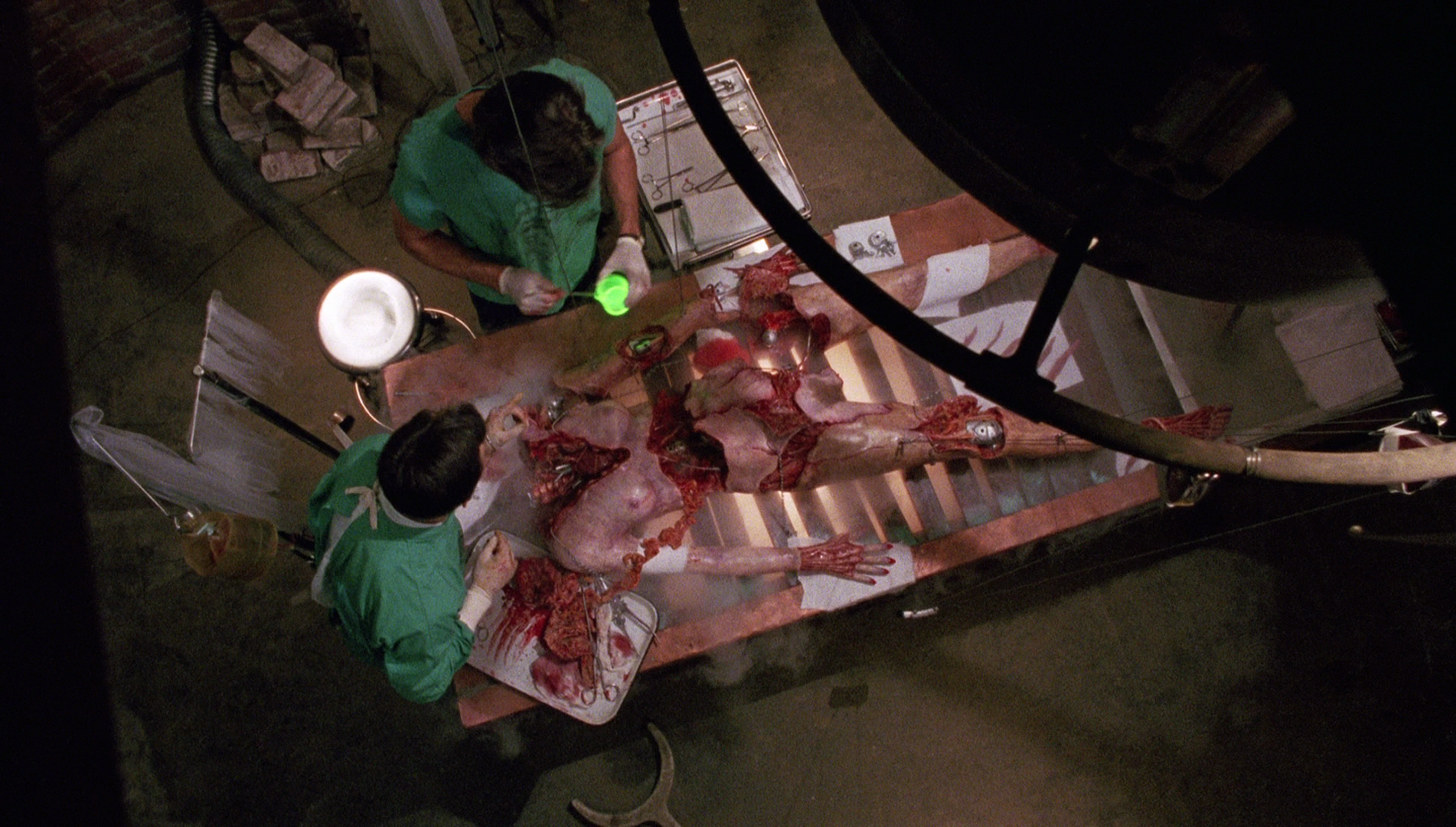 Returning to Arkham, Massachusetts, West and Cain take up positions at Miskatonic Hospital, the site of the massacre at the end of Re-Animator. Cain takes a shine to one of his patients, Gloria (Kathleen Kinmont) but also discovers, to his surprise, that Francesca has moved to the area. Meanwhile, Detective Lieutenant Chapham (Claude Earl Jones) approaches the hospital: Chapham’s wife was a victim of the infamous ‘Miskatonic Massacre’ and, her corpse reanimated by West’s reagent, is now incarcerated in an asylum. With a personal interest in getting to the bottom of the case, Chapham reveals to Dr Bruce Graves (Mel Stewart) that the severed head of West’s enemy Dr Hill (David Gale) was discovered at a carnival sideshow, in remarkably good condition without signs of decay. The other body parts discovered after the massacre, Graves tells Chapham, also show practically no signs of deterioration on a cellular level. Chapham suggests to Graves, correctly, that someone seems to be stealing body parts from the hospital. Returning to Arkham, Massachusetts, West and Cain take up positions at Miskatonic Hospital, the site of the massacre at the end of Re-Animator. Cain takes a shine to one of his patients, Gloria (Kathleen Kinmont) but also discovers, to his surprise, that Francesca has moved to the area. Meanwhile, Detective Lieutenant Chapham (Claude Earl Jones) approaches the hospital: Chapham’s wife was a victim of the infamous ‘Miskatonic Massacre’ and, her corpse reanimated by West’s reagent, is now incarcerated in an asylum. With a personal interest in getting to the bottom of the case, Chapham reveals to Dr Bruce Graves (Mel Stewart) that the severed head of West’s enemy Dr Hill (David Gale) was discovered at a carnival sideshow, in remarkably good condition without signs of decay. The other body parts discovered after the massacre, Graves tells Chapham, also show practically no signs of deterioration on a cellular level. Chapham suggests to Graves, correctly, that someone seems to be stealing body parts from the hospital.
At night, West sneaks into the room where the remains from the massacre are stored and takes the heart of Meg (played in the first film by Barbara Crampton), Cain’s lover. There, he discovers the head of Dr Hill, mocking his old enemy. Taking Meg’s heart, West retreats to the house he shares with Cain: the old caretaker’s house at the local cemetery. West experiments with his reagent in the basement of the house, reanimating various body parts and stowing the ‘rejects’ in a crypt that is adjacent to the house, accessible to West via a hole in the wall of the basement itself. West enlists Cain’s help in assembling a new lifeform, the ‘bride’ of the film’s title: constructed from various body parts, and with Meg’s heart at its centre, West only needs a fresh head and brain to complete his creation. When Gloria undergoes a cardiac arrest, West hastens her demise and uses her head for his ‘bride’. Meanwhile, Chapham approaches Francesca and explains to her West and Cain’s role in the massacre at the hospital, and a curious Graves injects some of West’s reagent (found at the scene of the massacre) into the severed head of Dr Hill, who uses his powers of hypnosis and telepathy to communicate with some of West’s ‘victims’ from the first film, now held in an asylum with Chapham’s wife. The stage is thus set for a grotesque showdown between West and his creations. 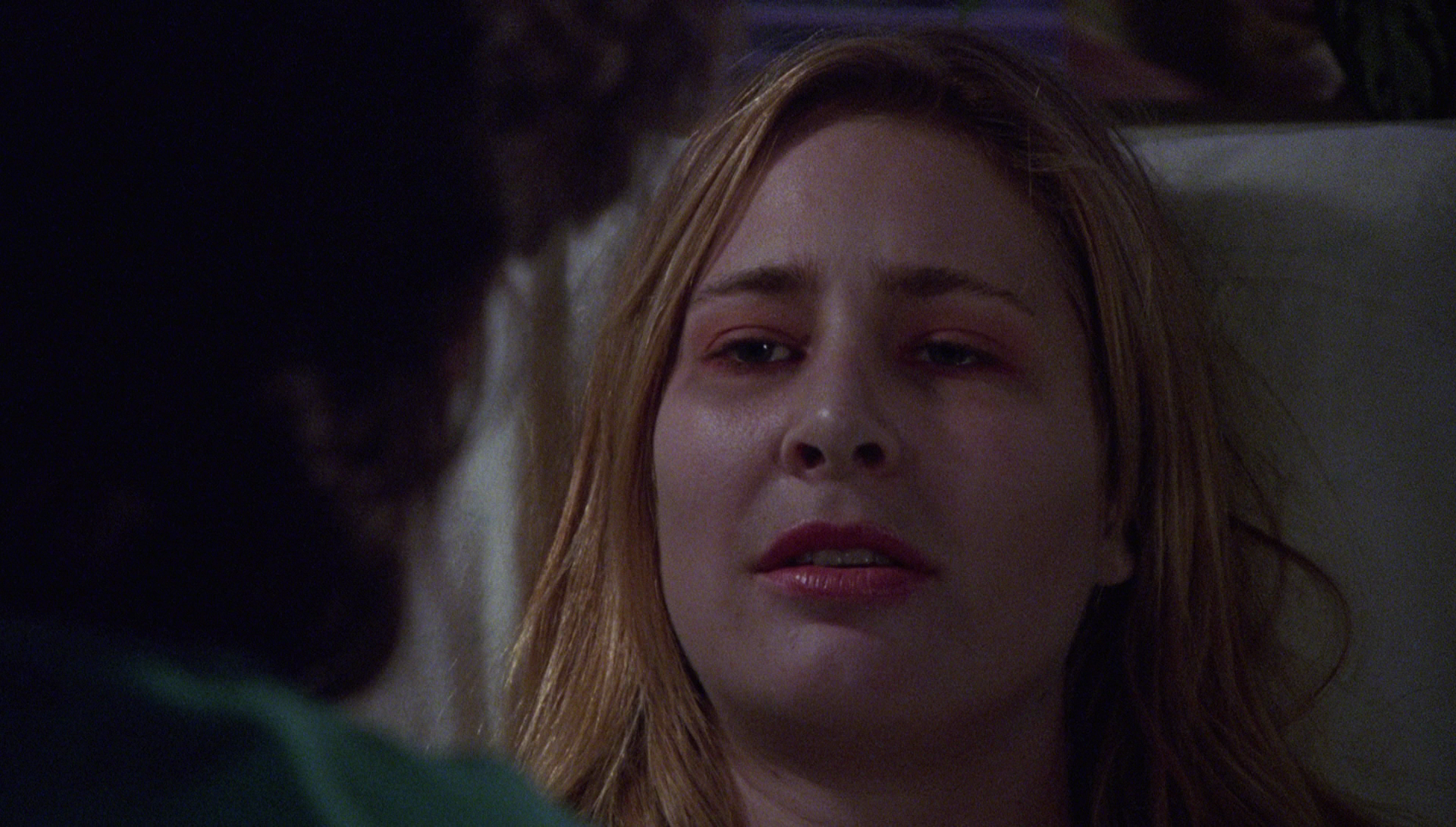 The novella on which Re-Animator had been based, Herbert West’s Re-Animator, was written by Lovecraft with the intention of it being published in a serialised format; this is reflected in the episodic structure of the novella, which takes the form of six very isolated chapters, each of which feels very much like a complete short story. Gordon’s Re-Animator took character names and narrative events from all six of the chapters, and wedded them together for a new story based in the present day; despite the lack of fidelity to the setting and story events of Lovecraft’s novella, Re-Animator is considered one of the most ‘successful’ attempts to translate Lovecraft’s writings to the big screen. A similar approach was taken with Bride of Re-Animator, which took an excerpt from Lovecraft’s novella in which West and Cain work as medics on the frontline during the First World War and used it as the basis for the opening sequence of Bride of Re-Animator, which finds the two not-so-good doctors working in exile as field surgeons during the civil war in Peru. The film’s climax also owes a strong debt to Lovecraft’s novella. The novella on which Re-Animator had been based, Herbert West’s Re-Animator, was written by Lovecraft with the intention of it being published in a serialised format; this is reflected in the episodic structure of the novella, which takes the form of six very isolated chapters, each of which feels very much like a complete short story. Gordon’s Re-Animator took character names and narrative events from all six of the chapters, and wedded them together for a new story based in the present day; despite the lack of fidelity to the setting and story events of Lovecraft’s novella, Re-Animator is considered one of the most ‘successful’ attempts to translate Lovecraft’s writings to the big screen. A similar approach was taken with Bride of Re-Animator, which took an excerpt from Lovecraft’s novella in which West and Cain work as medics on the frontline during the First World War and used it as the basis for the opening sequence of Bride of Re-Animator, which finds the two not-so-good doctors working in exile as field surgeons during the civil war in Peru. The film’s climax also owes a strong debt to Lovecraft’s novella.
Jon Towlson reminds us that Yuzna is, in his own words, ‘a former hippie’ for whom ‘the idea of politics as being not only important but entertaining and inextricably linked to art’ is integral (Yuzna, quoted in Towlson, 2014: 188). This aspect of Yuzna’s personality was evident in the films that Yuzna produced during the 1980s, including Re-Animator and From Beyond (Stuart Gordon, 1986), for example. Yuzna’s films as a director all contain a strong political subtext; this is more pronounced and explicit in some films than in others. For example, Society is openly political inasmuch as it satirises the wealthy elite within American society and the false consciousness they propagate in order to maintain their position at the top of the social hierarchy. Society contains an ‘unmistakeable’ message, according to Annalee Newitz: this message is simply that ‘the rich are repulsive alien monsters’ (Newitz, 2006: 3). Other films of Yuzna’s are more subtly political; but common to many of them is an examination of corrupt male authority. Towlson suggests that in Yuzna’s pictures as both director and producer, ‘patriarchal authority in all its forms is open to question, whether it be the military (Return of the Living Dead 3), men’s control of women’s bodies (Bride of Re-animator, Initiation, Progeny), or masculinity itself (The Dentist, The Dentist 2)’ (ibid.). The films ‘also display a developed class-consciousness colored by 1960s radicalism’ in which Yuzna seems to ‘see capitalist society as a hidden oligarchy in which the majority of wealth is kept by a small minority of rich families while the poor are exploited and “fed upon”’ (ibid.). 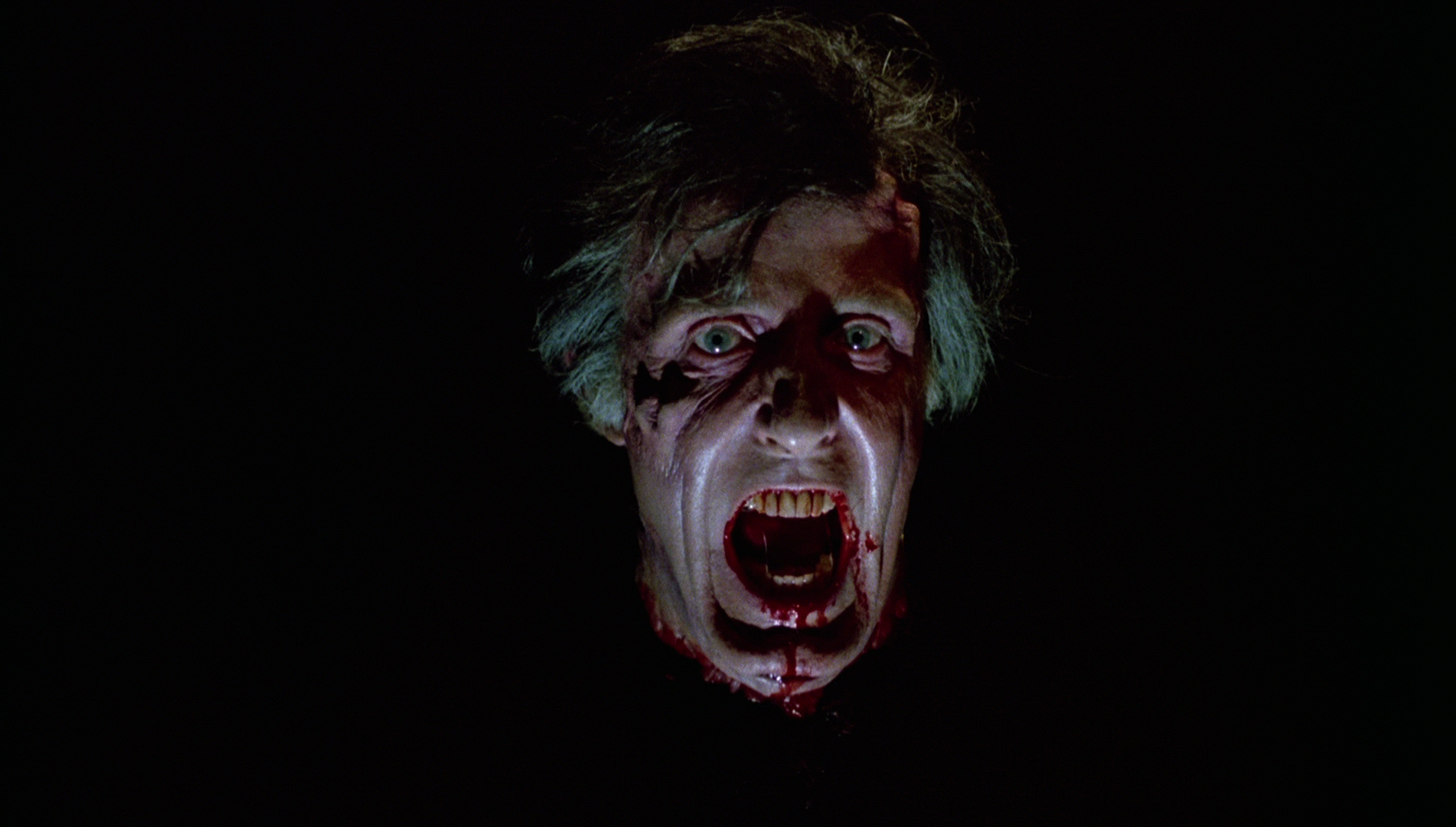 Reflecting on his movement from producing to directing, Yuzna once asserted that ‘It’s [wishing to direct is] a natural thing to do if you work with movies anyway’ (Yuzna, quoted in Fischer, 2000: 660). However, Yuzna admits that at this stage in his career, he paid more attention to ideas than to the construction of the films’ narratives, stating in interview that ‘I always put try to put much more in the stories than they can support because I’m an idea person’ (Yuzna, quoted in ibid.: 661). Partly, Yuzna suggest, this is owing to the fact that Yuzna came relatively late to the film world: ‘I had been a carpenter and an artist and when I was 35 I decided to make movies whereas Stuart [Gordon] had been working on staging and story and direction’ and therefore had more institutional support and grounding in issues of narrative (Yuzna, quoted in ibid.). Structurally, Yuzna’s films are linked by ‘a strong element of the carnivalesque’ which explodes in a finale that takes the form of ‘big, transgressive, crazy, orgiastic type scenes’ (Yuzna, quoted in Towler, op cit.: 189). Yuzna has claimed that these sequences of excess are in some way shaped by his viewings, as a child, of Hollywood epics such as The Ten Commandments (Cecil B DeMille, 1956) and Ben-Hur (William Wyler, 1959) (Yuzna, cited in ibid.). Reflecting on his movement from producing to directing, Yuzna once asserted that ‘It’s [wishing to direct is] a natural thing to do if you work with movies anyway’ (Yuzna, quoted in Fischer, 2000: 660). However, Yuzna admits that at this stage in his career, he paid more attention to ideas than to the construction of the films’ narratives, stating in interview that ‘I always put try to put much more in the stories than they can support because I’m an idea person’ (Yuzna, quoted in ibid.: 661). Partly, Yuzna suggest, this is owing to the fact that Yuzna came relatively late to the film world: ‘I had been a carpenter and an artist and when I was 35 I decided to make movies whereas Stuart [Gordon] had been working on staging and story and direction’ and therefore had more institutional support and grounding in issues of narrative (Yuzna, quoted in ibid.). Structurally, Yuzna’s films are linked by ‘a strong element of the carnivalesque’ which explodes in a finale that takes the form of ‘big, transgressive, crazy, orgiastic type scenes’ (Yuzna, quoted in Towler, op cit.: 189). Yuzna has claimed that these sequences of excess are in some way shaped by his viewings, as a child, of Hollywood epics such as The Ten Commandments (Cecil B DeMille, 1956) and Ben-Hur (William Wyler, 1959) (Yuzna, cited in ibid.).
Bride of Re-Animator opens in a spectacularly blackly comic fashion, with Dr Hill’s severed head floating across a black screen. Yuzna cites William Castle’s The House on Haunted Hill (1959) as an influence on this scene, but the effect is also rather like that of the prologue to John Boorman’s Zardoz (1974), added to the film following pressure from the studio to make the film’s plot more explicit, and which features the disembodied head of Arthur Frayn introducing the film’s narrative events whilst also reminding the viewer of how the film is a construct, a work of fiction: ‘I am Arthur Frayn, and I am Zardoz. I have lived three hundred years, and I long to die’, Frayn declares, ‘But death is no longer possible. I am immortal [….] Man is my hero. I am the puppet master. I manipulate many of the characters and events you will see’. However, as Frayn reminds the audience, he himself is ‘invented too for your entertainment and amusement. And you, poor creatures’, he asks, ‘who conjured you out of the clay? Is God in showbusiness too?’. By contrast, Hill’s appearance at the start of Bride of Re-Animator, though superficially similar (ie, a disembodied head floating against a black backdrop), simply finds the character offering a statement of revenge, addressing the film’s viewer as if s/he were West: ‘West, you bastard’, Hill asserts through bloodied teeth, ‘You did this to me. But you’ll not escape me. Not this time’. 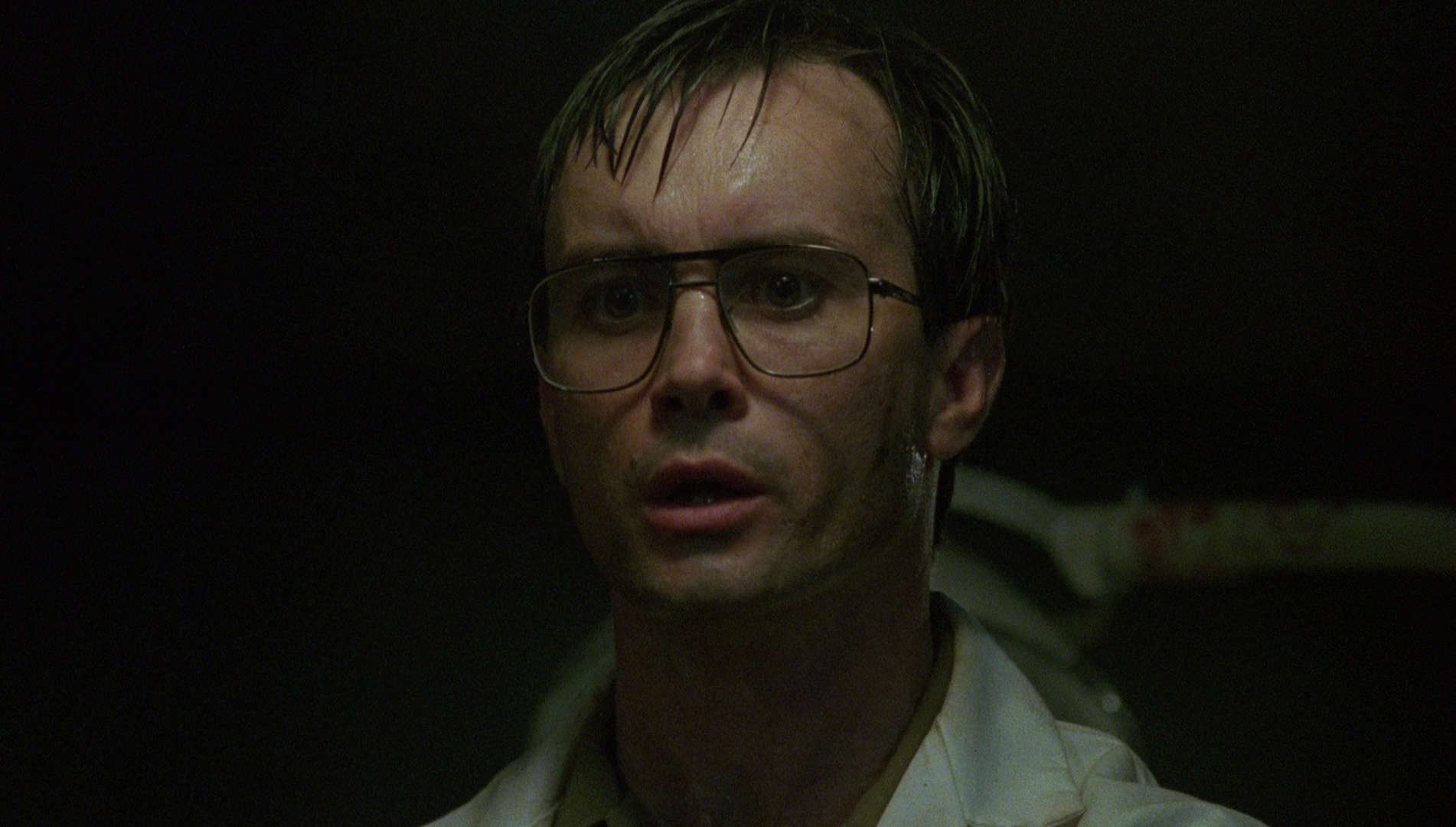 As in the first film, West and Cain are absolute contrasts: the wholly rational West represents the mind, and the more emotional and sympathetic Cain represents the heart. At the start of the film, West claims to have discovered that each part of the human body can exist independently: that as opposed to hegemonic centralism (the idea that consciousness resides in the brain), consciousness exists within every part of the body, all of which can be reanimated separately. (The contrast between centralism and the notion of the ‘embodied’ self is one which has been negotiated through numerous versions of the Frankenstein story: Terence Fisher’s run of Frankenstein pictures for Hammer see an evolving approach towards the notion of the ‘self’, for example.) ‘Reticular consciousness is not in the brain’, West asserts in one of Bride of Re-Animator’s very early sequences, ‘We know that, yes? We’ve gone beyond that [….] This is no longer about just re-animating the dead: we will create new life’. West’s intention to build a ‘new life’, which is realised as the film goes on through West’s assembly of his ‘bride’ from parts of a number of different bodies, makes his project in this film similar to that of Frankenstein in Mary Shelley’s novel. By placing Meg’s heart at the centre of his creation, West intends to coax Cain into assisting him; around Meg’s heart are built the parts of various dead bodies, including Gloria’s head and brain. West even goes so far as to combine within his ‘bride’s body parts which suggest dualistic traits: showing Cain the composite corpse, West declares, ‘The feet of a young ballet dancer who ended her life when she lost her ambition. These legs… walked the streets. Do you remember the hooker who was killed in ER last week? Think of all the bodies these legs have wrapped around. What was the value of her life? […] And here, the womb of a virgin, struck down before tasting the pleasures of life’. This marriage of opposites continues with the ‘bride’s hands, one of which is from a lawyer and the other from a murderess. ‘But they’re all equal now’, West suggests, ‘Nothing but cast off remnants of a meaningless existence [….] Just dead tissue. But in our hands, it’s the clay of life’. West manages to convince that because the ‘bride’ contains Meg’s heart, it is somehow a re-animated version of Cain’s dead lover. This illusion is, however, punctured by Francesca. ‘Who is she?’, Francesca asks upon seeing the re-animated ‘bride’. ‘It’s Meg’, Cain says, in awe of the creation. ‘Meg’s dead’, Francesca reminds him, simply. As in the first film, West and Cain are absolute contrasts: the wholly rational West represents the mind, and the more emotional and sympathetic Cain represents the heart. At the start of the film, West claims to have discovered that each part of the human body can exist independently: that as opposed to hegemonic centralism (the idea that consciousness resides in the brain), consciousness exists within every part of the body, all of which can be reanimated separately. (The contrast between centralism and the notion of the ‘embodied’ self is one which has been negotiated through numerous versions of the Frankenstein story: Terence Fisher’s run of Frankenstein pictures for Hammer see an evolving approach towards the notion of the ‘self’, for example.) ‘Reticular consciousness is not in the brain’, West asserts in one of Bride of Re-Animator’s very early sequences, ‘We know that, yes? We’ve gone beyond that [….] This is no longer about just re-animating the dead: we will create new life’. West’s intention to build a ‘new life’, which is realised as the film goes on through West’s assembly of his ‘bride’ from parts of a number of different bodies, makes his project in this film similar to that of Frankenstein in Mary Shelley’s novel. By placing Meg’s heart at the centre of his creation, West intends to coax Cain into assisting him; around Meg’s heart are built the parts of various dead bodies, including Gloria’s head and brain. West even goes so far as to combine within his ‘bride’s body parts which suggest dualistic traits: showing Cain the composite corpse, West declares, ‘The feet of a young ballet dancer who ended her life when she lost her ambition. These legs… walked the streets. Do you remember the hooker who was killed in ER last week? Think of all the bodies these legs have wrapped around. What was the value of her life? […] And here, the womb of a virgin, struck down before tasting the pleasures of life’. This marriage of opposites continues with the ‘bride’s hands, one of which is from a lawyer and the other from a murderess. ‘But they’re all equal now’, West suggests, ‘Nothing but cast off remnants of a meaningless existence [….] Just dead tissue. But in our hands, it’s the clay of life’. West manages to convince that because the ‘bride’ contains Meg’s heart, it is somehow a re-animated version of Cain’s dead lover. This illusion is, however, punctured by Francesca. ‘Who is she?’, Francesca asks upon seeing the re-animated ‘bride’. ‘It’s Meg’, Cain says, in awe of the creation. ‘Meg’s dead’, Francesca reminds him, simply.
In the opening sequence, West demonstrates utter cynicism in his work as a field medic in Peru. When one of the combatants in his and Cain’s care dies, West declares cruelly, ‘His central nervous system is still intact’. Referring obliquely to his experiments with the reagent, West asserts that ‘He [the dead guerilla] may still prove to be useful; more useful than he’d be otherwise’. Later, West demonstrates a similar methodology when Gloria passes and, delivering a sideways glance towards Cain, West makes the decision to split her sternum open and massage her heart; the suggestion to the film’s viewer, conveyed through aspects of Combs’ performance (furtive glances, a subtle leer), is that the procedure is unnecessary and West initiates it in order to ensure that Gloria dies, thus allowing him to use her head and brain for his ‘bride’. Earlier sequences have already established West’s design for Gloria: in the scene in which Gloria is introduced as a young woman who is scared about the surgery she must undergo, Cain notices West’s glances towards her and tells West ‘She’s not an experiment’. ‘She’s terminal’, West responds matter-of-factly. ‘She’s a patient’, Cain reminds him. ‘She could be of use to us, Dan’, West says. ‘I’m a doctor’, Cain reminds West. ‘Well, be a scientist’, West declares, suggesting that the two roles have very different responsibilities. West clearly perceives himself as the latter, seeing the preservation of human life (his role as a doctor) as immaterial to his experiments – or perhaps even regarding the practice of medicine as counterproductive. For West, being a doctor isn’t a vocation or a calling: it’s simply a means by which he can acquire fresh ‘material’ (whole cadavers and body parts) for his experiments. Interestingly, when questioned by Chapham, West suggests that his experiments have gone beyond theory and experimentation: ‘When I was in medical school, I suppose I had the time to discuss theory’, West tells the detective, ‘I don’t anymore’.  Fittingly, given the excessive, carnivalesque nature of the film, we are told by Chapham that Dr Hill’s severed head was discovered as part of a carnival sideshow, though perhaps surprisingly Yuzna sidesteps the opportunity to present whatever exhibit Hill’s head appeared in to the viewer. The head is placed in storage with the rest of the body parts from the so-called ‘Miskatonic Massacre’. When West discovers Hill’s head in the store, he chuckles. ‘How did you get back here?’, he jokes before mocking the theories that Hill, West’s enemy and former teacher, presented in the first film; theories that through his experiments with the reagent, West proved incorrect. ‘What do you think of the location of the will in the brain now, Dr Hill?’, West quips, ‘Actually, you’ve been quite useful to me. You’ve helped me to prove that consciousness resides in every part of the body’. West concludes his encounter with Hill’s inanimate head by making a series of very bad puns: ‘Look at you now’, West says, ‘You’re nothing but a “dead head”; a “no body”’. Fittingly, given the excessive, carnivalesque nature of the film, we are told by Chapham that Dr Hill’s severed head was discovered as part of a carnival sideshow, though perhaps surprisingly Yuzna sidesteps the opportunity to present whatever exhibit Hill’s head appeared in to the viewer. The head is placed in storage with the rest of the body parts from the so-called ‘Miskatonic Massacre’. When West discovers Hill’s head in the store, he chuckles. ‘How did you get back here?’, he jokes before mocking the theories that Hill, West’s enemy and former teacher, presented in the first film; theories that through his experiments with the reagent, West proved incorrect. ‘What do you think of the location of the will in the brain now, Dr Hill?’, West quips, ‘Actually, you’ve been quite useful to me. You’ve helped me to prove that consciousness resides in every part of the body’. West concludes his encounter with Hill’s inanimate head by making a series of very bad puns: ‘Look at you now’, West says, ‘You’re nothing but a “dead head”; a “no body”’.
Validating his idea that any body part can be reanimated independently, West demonstrates his new theory of the self through assembling bizarre creatures who are made of various parts of dead bodies. (West even incorporates this philosophy into his advice to Cain, when Cain discovers that the lovely Francesca lives near the hospital: ‘Don’t let the little head rule the big head, Dan’.) West’s premise is used as the basis for some grisly, surrealistic special effects work by Screaming Mad George and KNB. Like both Re-Animator and Yuzna’s directorial debut Society (1989, which we have reviewed here), Bride of Re-Animator is at heart a splatter film and part of the boom of ‘body horror’ pictures made during the 1970s and 1980s that also included the likes of David Cronenberg’s Rabid (1976) and The Fly (1986). Specifically, the notion that each part of an individual’s body can exist independently from the others connects Bride of Re-Animator to John Carpenter’s 1982 remake of The Thing: ‘Watching Norris in there gave me the idea that maybe every part of him was a whole, every little piece was an individual animal with a built-in desire to protect its own life’, Kurt Russell’s R J MacReady says in that film, ‘You see, when a man bleeds, it's just tissue; but blood from one of you Things won't obey when it's attacked. It'll try and survive; crawl away from a hot needle, say’. 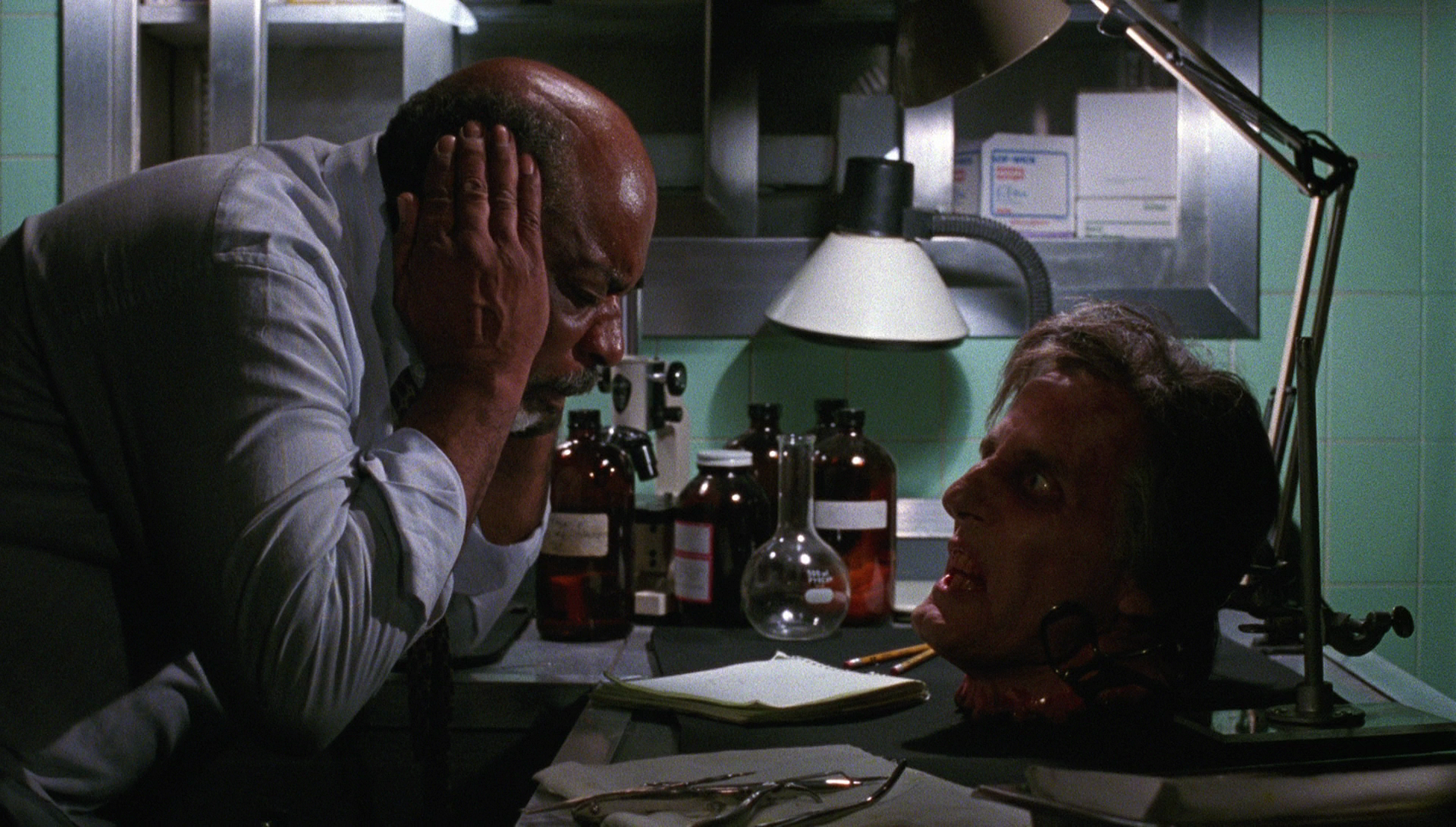 Both Society and Bride of Re-Animator feature special effects work by Screaming Mad George, whose effects foreground the film’s grisly ‘body-in-pieces’ approach and use techniques such as stop motion to visualise West’s bizarre experiments. These experiments include attaching a forearm to a leg (which, after the reagent is applied, attempts to attack West by alternately kicking and throttling him), and marrying an eyeball to a number of severed fingers in a grotesque parody of a spider. ‘This is the key to creating life’, West tells Cain, ‘Parts. Re-animated parts’. ‘We’re trying to save whole people, not parts’, Cain reminds West, reinforcing the aforementioned doctor-scientist dualism that characterises their relationship. To this, West responds by asserting his own philosophy of the self: ‘Exactly, and what are people, Dan, over and above a collection of living parts? We can create new life’. These ‘rejects’ West hides in the crypt that is adjacent to his and Cain’s house, which West accesses via a hole in the wall of the basement. Much like the end of the first picture (and true to Lovecraft’s source novella), at the climax of Bride of Re-Animator these ‘rejects’ spill out of the crypt and attack West, their creator; their bizarre qualities (for example, a corpse with two faces, like the Roman god Janus) heighten the carnivalesque aspects of the film. Both Society and Bride of Re-Animator feature special effects work by Screaming Mad George, whose effects foreground the film’s grisly ‘body-in-pieces’ approach and use techniques such as stop motion to visualise West’s bizarre experiments. These experiments include attaching a forearm to a leg (which, after the reagent is applied, attempts to attack West by alternately kicking and throttling him), and marrying an eyeball to a number of severed fingers in a grotesque parody of a spider. ‘This is the key to creating life’, West tells Cain, ‘Parts. Re-animated parts’. ‘We’re trying to save whole people, not parts’, Cain reminds West, reinforcing the aforementioned doctor-scientist dualism that characterises their relationship. To this, West responds by asserting his own philosophy of the self: ‘Exactly, and what are people, Dan, over and above a collection of living parts? We can create new life’. These ‘rejects’ West hides in the crypt that is adjacent to his and Cain’s house, which West accesses via a hole in the wall of the basement. Much like the end of the first picture (and true to Lovecraft’s source novella), at the climax of Bride of Re-Animator these ‘rejects’ spill out of the crypt and attack West, their creator; their bizarre qualities (for example, a corpse with two faces, like the Roman god Janus) heighten the carnivalesque aspects of the film.
West’s hubris is what leads to his downfall, once again. After reanimating the ‘bride’, West is shocked to discover that she shies away from him. ‘I made you’, he protests weakly. ‘With my hands, I created what no man’s mind or woman’s womb could hope to achieve’, West declares. ‘This is blasphemy’, Francesca suggests. ‘Blasphemy?’, West responds incredulously, ‘Before what God? [….] I will not be shackled by the failures of your God. The only blasphemy is to wallow in insignificance. I have taken refuse of your God’s failures, and I have triumphed. There is my creation’, he asserts, indicating towards the ‘bride’. However, after the ‘bride’ attacks Francesca, both Cain and West turn against her. ‘Leave her [Francesca] alone, you monster’, Cain asserts. In response to this, West tells Cain to ‘Forget it, Dan. She’s just an assembly of dead tissue’. This causes the ‘bride’ to, for want of a better way of putting it, self-destruct. ‘Make a note of it, Dan. Tissue rejection’, West declares dryly as she does so.
Video
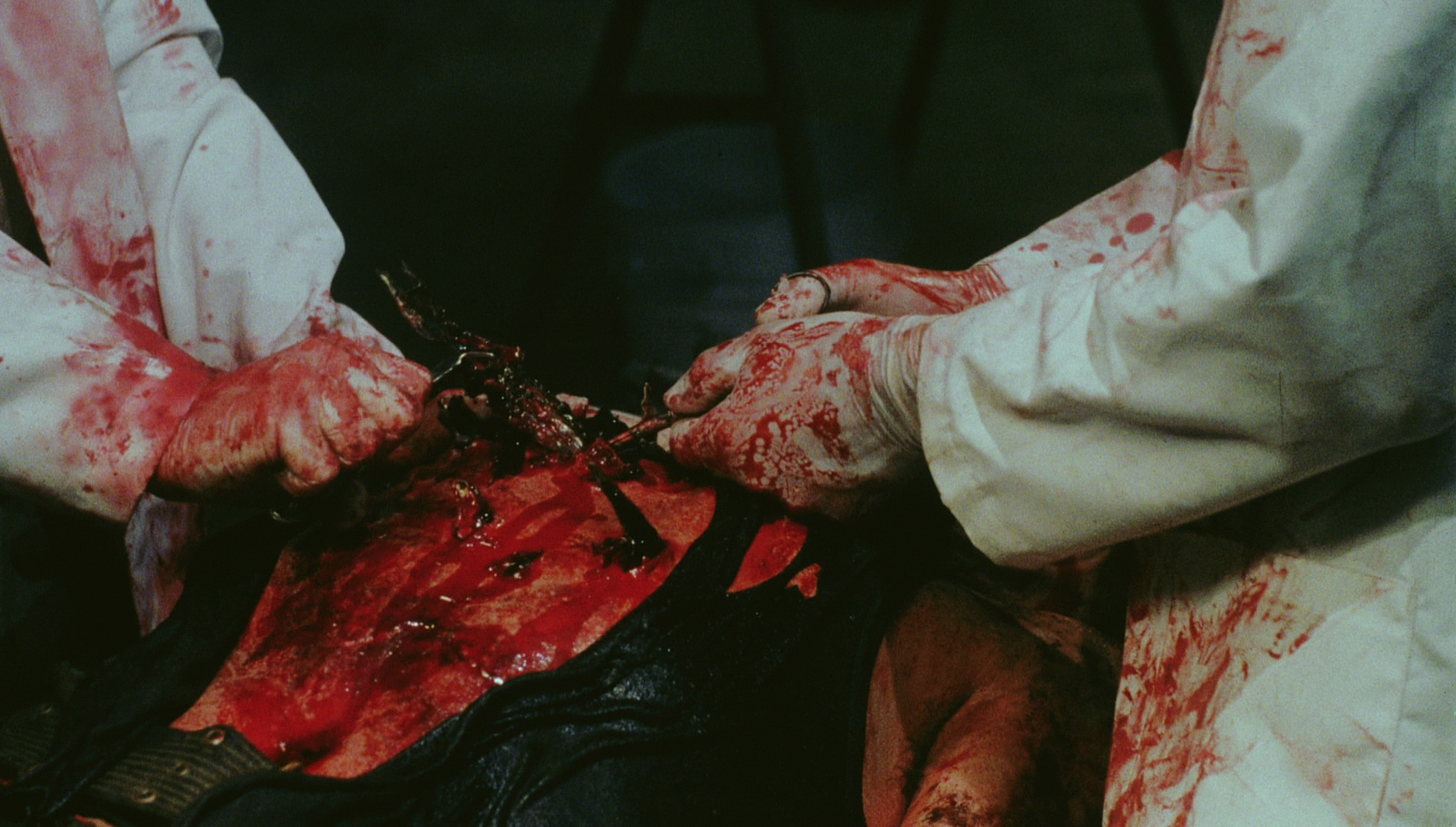 Arrow’s release of Bride of Re-Animator contains both the unrated version of the film and the ‘R’ rated cut, housed on separate discs. Both versions of the film are presented in 1080p, using the AVC codec, and are offered in the 1.78:1 screen ratio. Arrow’s release of Bride of Re-Animator contains both the unrated version of the film and the ‘R’ rated cut, housed on separate discs. Both versions of the film are presented in 1080p, using the AVC codec, and are offered in the 1.78:1 screen ratio.
The difference in running time between the two cuts of the film is miniscule: the unrated cut runs for 97:44 mins, whilst the ‘R’ rated version runs for 97:45 mins. The differences between the two cuts of the film can be accounted for by the use of alternate takes in the ‘R’ rated version. For example, in the opening sequence, the unrated version features a few tighter close-ups during the moment in which West and Cain tend to the guerilla’s gory chest wound. Just about every scene featuring gore footage is presented differently in the unrated cut as compared with the ‘R’ rated version, although owing to the fact that these sequences play out differently in the ‘R’ rated cut because of substitutions rather than cuts per se, there’s little difference in terms of the length of each scene and of the film as a whole. A detailed visual comparison of the differences between the two cuts of the film can be found here: http://www.movie-censorship.com/report.php?ID=5127433. Both cuts of the film take up around 27Gb on their respective discs. The presentations are based on the same restorations used for the Capelight Blu-ray release of Bride of Re-Animator that appeared in Germany in 2014. The ‘R’ rated version, the text tells us, is based on a 2k scan of a second generation intermediate interpositive. The unrated version is based on a DeLuxe composite master positive print. There’s a noticeable jump in quality for some of the footage exclusive to the unrated cut, with this footage seeming a little more coarse, more ‘contrasty’ and possessing a little less clarity. 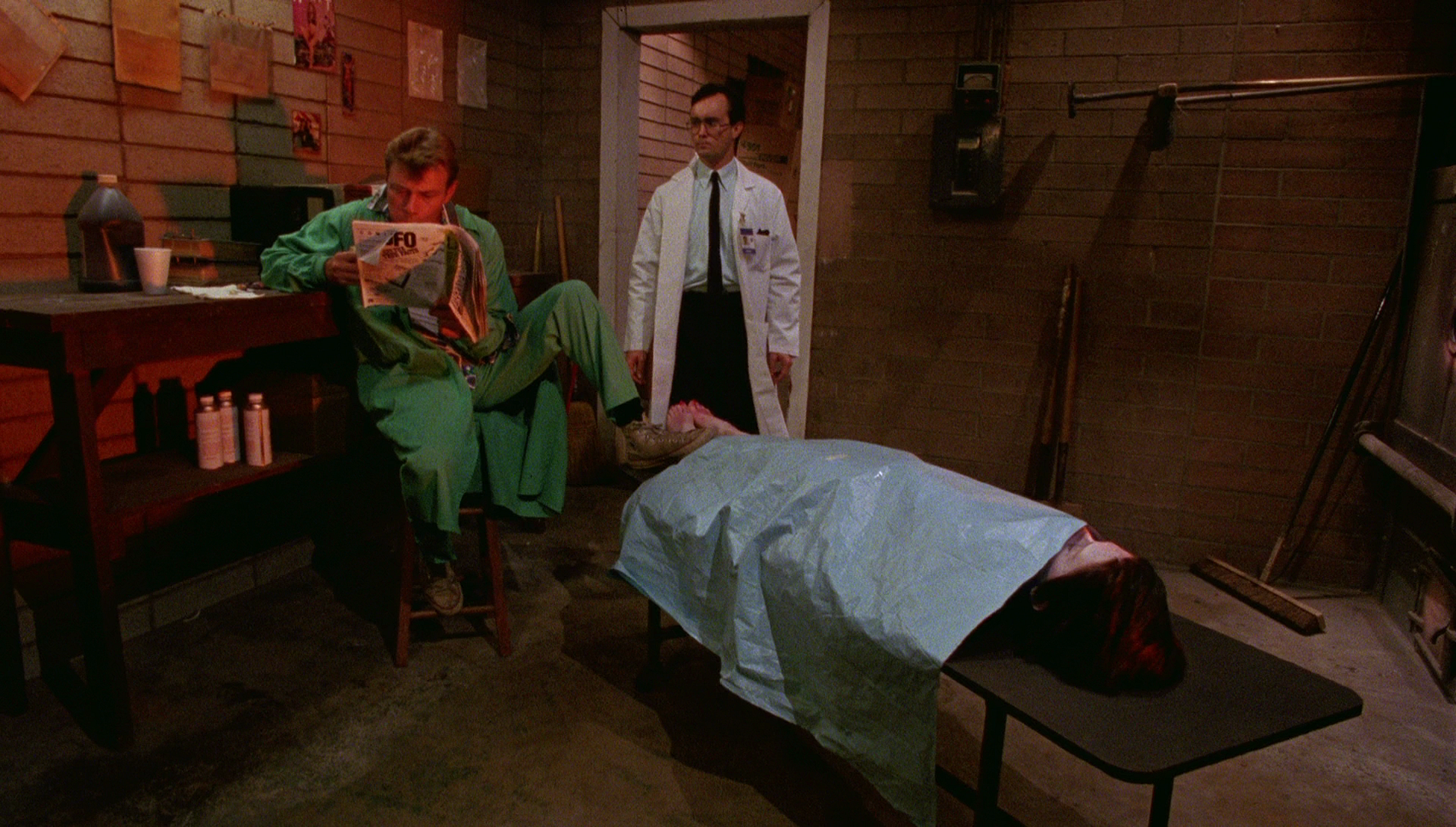 From the opening sequences onwards, contrast is handled nicely by the presentation: in the field hospital in Peru, for example, West and Cain are picked up by the light, with the rest of the scene tapering off into darkness behind them. As this is a presentation based on sources removed by at least one generation from the film’s negative, there are some low light sequences in which shadow detail seems just slightly ‘crushed’ into black, but that’s a characteristic of the source/s used for this presentation and, in the grand scheme of things, is a very minor detail. Colour consistency is a big area of improvement over the film’s previous DVD releases; this is particularly noticeable in some of the sequences which feature the sets and actors bathed in green and red light. The level of detail is also impressive, giving the images a striking sense of depth and texture. The encode is one area in which this release differs from the German Blu-ray release from Capelight (though admittedly, that release was no slouch in that department either). Arrow’s new Blu-ray contains a characteristically strong encode which retains the structure of 35mm film. From the opening sequences onwards, contrast is handled nicely by the presentation: in the field hospital in Peru, for example, West and Cain are picked up by the light, with the rest of the scene tapering off into darkness behind them. As this is a presentation based on sources removed by at least one generation from the film’s negative, there are some low light sequences in which shadow detail seems just slightly ‘crushed’ into black, but that’s a characteristic of the source/s used for this presentation and, in the grand scheme of things, is a very minor detail. Colour consistency is a big area of improvement over the film’s previous DVD releases; this is particularly noticeable in some of the sequences which feature the sets and actors bathed in green and red light. The level of detail is also impressive, giving the images a striking sense of depth and texture. The encode is one area in which this release differs from the German Blu-ray release from Capelight (though admittedly, that release was no slouch in that department either). Arrow’s new Blu-ray contains a characteristically strong encode which retains the structure of 35mm film.
Some large screen grabs comparing this release with the German Blu-ray release from Capelight are included at the bottom of this review.  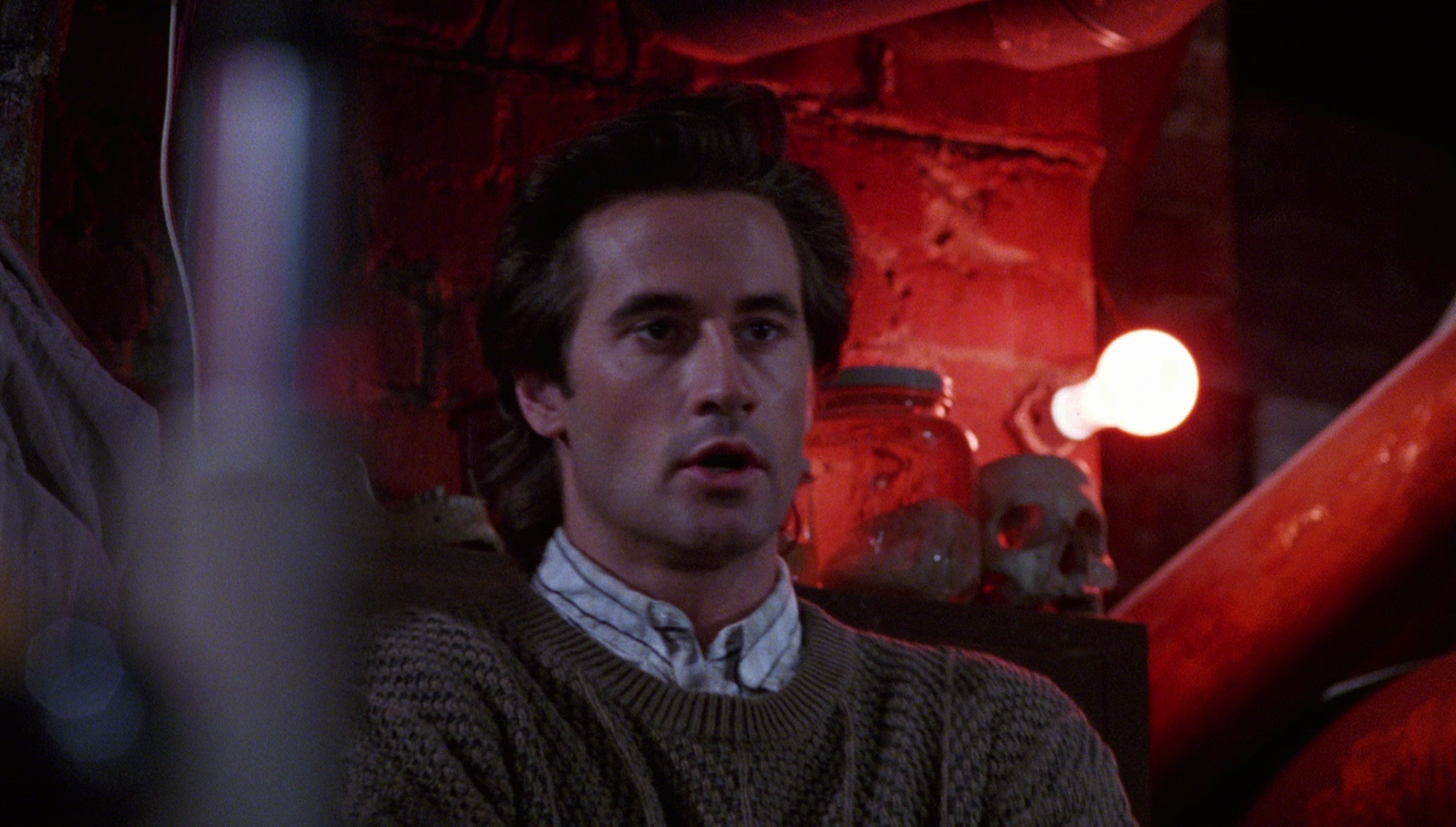 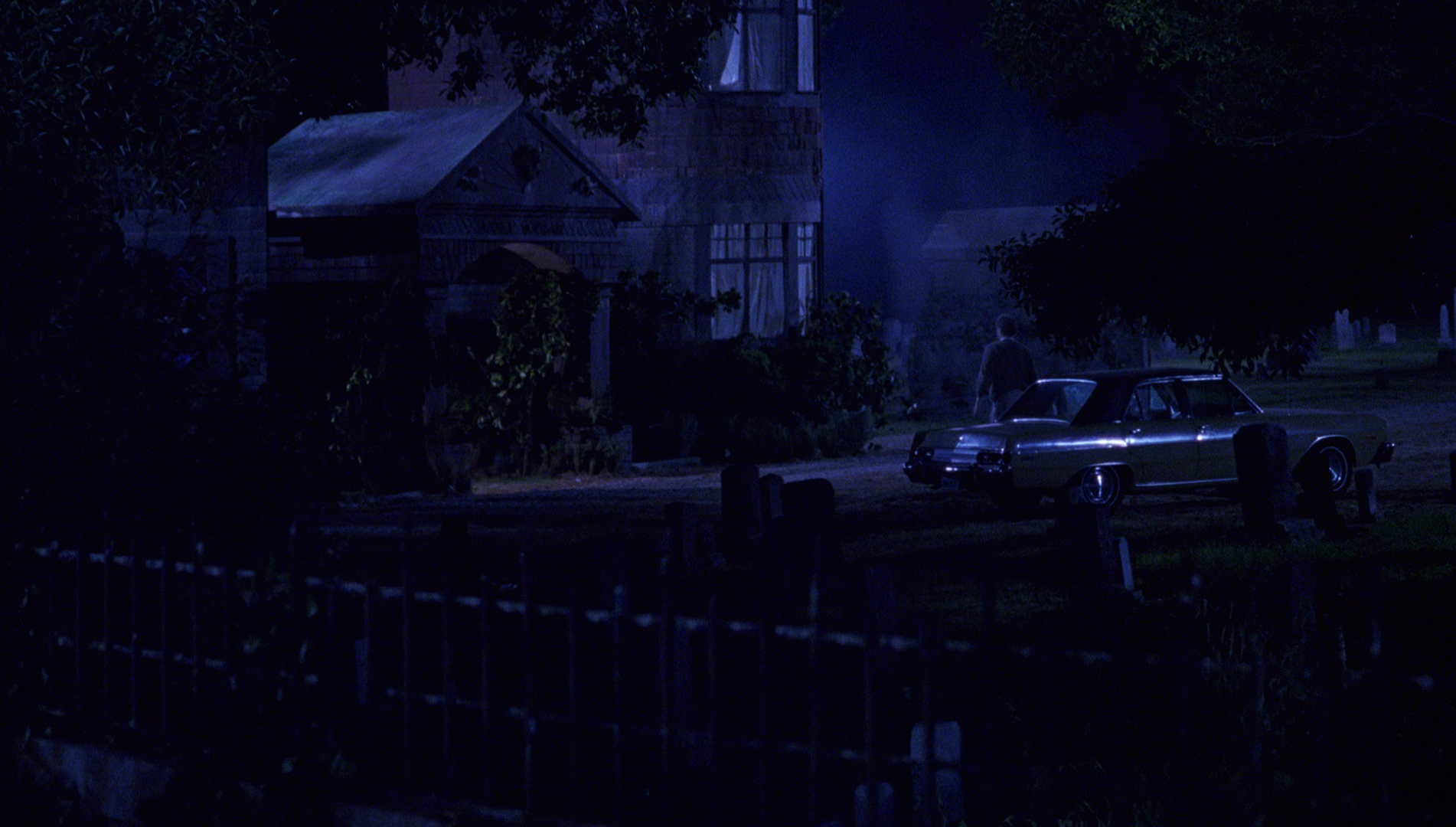
Audio
Audio is presented on both cuts of the film via a LPCM 2.0 stereo track, which is accompanied by optional English subtitles for the Hard of Hearing. On Capelight’s German Blu-ray release, the English track suffered from an audible hum that dominated the track and made some of the dialogue and effects a little ‘fuzzy’. The good news is that Arrow’s new Blu-ray release, though apparently still using the same audio track, seems to have undergone a little extra ‘clean up’: the audio track on Arrow’s disc is sans the ‘fuzz’ of the German Blu-ray release, with the effect that the dialogue and effects sound much ‘cleaner’.
Extras
DISC ONE: 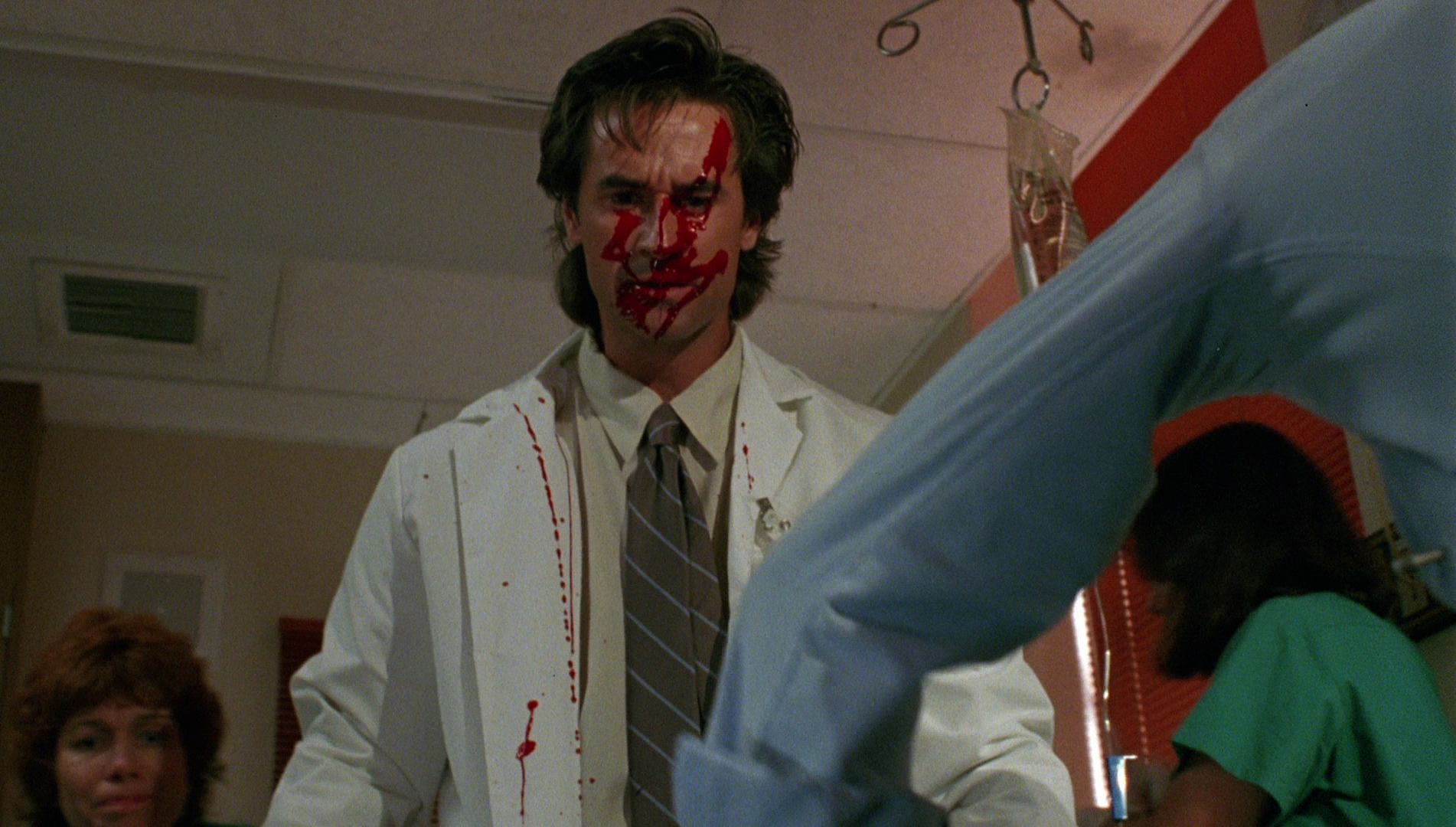 * The Film: Unrated cut (97:44). * The Film: Unrated cut (97:44).
- Audio commentary with director Brian Yuzna. Here, in a new commentary track moderated by David Gregory, Yuzna talks about the process of shooting the film and reflects on the creative decisions made during the scripting and production stages. He also discusses the film’s reception in some detail. - Audio commentary with cast and crew. This commentary features Yuzna, Combs, effects artists Howard Berger and Robert Kurtzman, Thomas Rainone (special effects co-ordinator) and Michael Deak (effects designer and supervisor), Screaming Mad George and John Carl Buechler. This track has been heard on a number of the film’s previous releases beginning with the US DVD release from Pioneer, and it’s a lively, fun track recorded approximately ten years after the film’s release. - Audio commentary with Jeffrey Combs and Bruce Abbott. This is another commentary which has appeared on previous DVD releases of the film, beginning with the American release from Pioneer. Combs and Abbott have much fun reflecting on the film, and this track is a joy to listen to. - ‘Brian Yuzna Remembers Bride’ (9:37). In a new interview, Yuzna talks about the origins of Bride of Re-Animator. The project began with an adaptation of Lovecraft’s Shadow Over Innsmouth, which evolved into Stuart Gordon’s Dagon (2001). The original idea for the narrative was to have followed Cain and Meg, with Cain working as a caretaker and hiding the re-animated Meg. Cain and West would eventually work in the White House, where they would have re-animated the assassinated President (Reagan). This storyline wasn’t fully scripted and was eventually abandoned. When the film was rushed into production with a smaller budget and a shorter shooting schedule than it needed, another script was hastily assembled. ‘We threw a lot of pasta to see what would stick, and a lot of oddball stuff stuck’, Yuzna says. Yuzna also talks about the film’s distribution and reception.  - ‘Splatter Masters’ (14:39). In a new featurette, Yuzna, Robert Kurtzman, Screaming Mad George, Tony Doublin and John Carl Buechler talk about the film’s effects. The participants are interviewed separately. Kurtzman talks about the origins of KNB Effects. Buechler discusses the approach to ‘animating’ Hill’s head. Screaming Mad George reflects on his work for the film, which was confined to the film’s climax. Buechler suggests that Screaming Mad George’s work is heavily influenced by the work of the surrealists, and Yuzna’s approach was similar – offering ‘a marriage made in hell’. Yuzna talks about the film’s effects as ‘doodling with body parts’. The effects for the ‘bride’ are examined in detail by Kurtzman, as are many of the film’s other effects sequences. - ‘Splatter Masters’ (14:39). In a new featurette, Yuzna, Robert Kurtzman, Screaming Mad George, Tony Doublin and John Carl Buechler talk about the film’s effects. The participants are interviewed separately. Kurtzman talks about the origins of KNB Effects. Buechler discusses the approach to ‘animating’ Hill’s head. Screaming Mad George reflects on his work for the film, which was confined to the film’s climax. Buechler suggests that Screaming Mad George’s work is heavily influenced by the work of the surrealists, and Yuzna’s approach was similar – offering ‘a marriage made in hell’. Yuzna talks about the film’s effects as ‘doodling with body parts’. The effects for the ‘bride’ are examined in detail by Kurtzman, as are many of the film’s other effects sequences.
- ‘Getting Ahead in Horror’ (23:50). This is an archival piece which has been seen on some of the film’s previous home video releases. Shot on video, it features behind the scenes footage and interviews with the cast and crew during the production of the picture. - Deleted Scenes: ‘Meg is Re-Animated’ (8:04); ‘Carnival Sequence’ (2:03). ‘Meg is Re-Animated’ focuses on the shooting of a scene not included in the final cut of Bride of Re-Animator and intended to offer an immediate continuation of the final scene in Re-Animator, in which Cain uses West’s reagent to bring Meg back to life. The presentation here mingles behind the scenes footage with the scene itself. ‘Carnival Sequence’ features the cast and crew discussing a deleted scene in which Chapham discovers Dr Hill’s severed head at a carnival sideshow. Their comments are presented over still frames from the scene itself (which was presumably either never completed or no longer exists). - Trailer (1:53). DISC TWO: * The Film: ‘R’ rated cut (97:45) - Behind the Scenes Reel (14:30). This is a compilation of footage (shot on video) during the production of the film. Most of it focuses on the effects sequences.
Overall
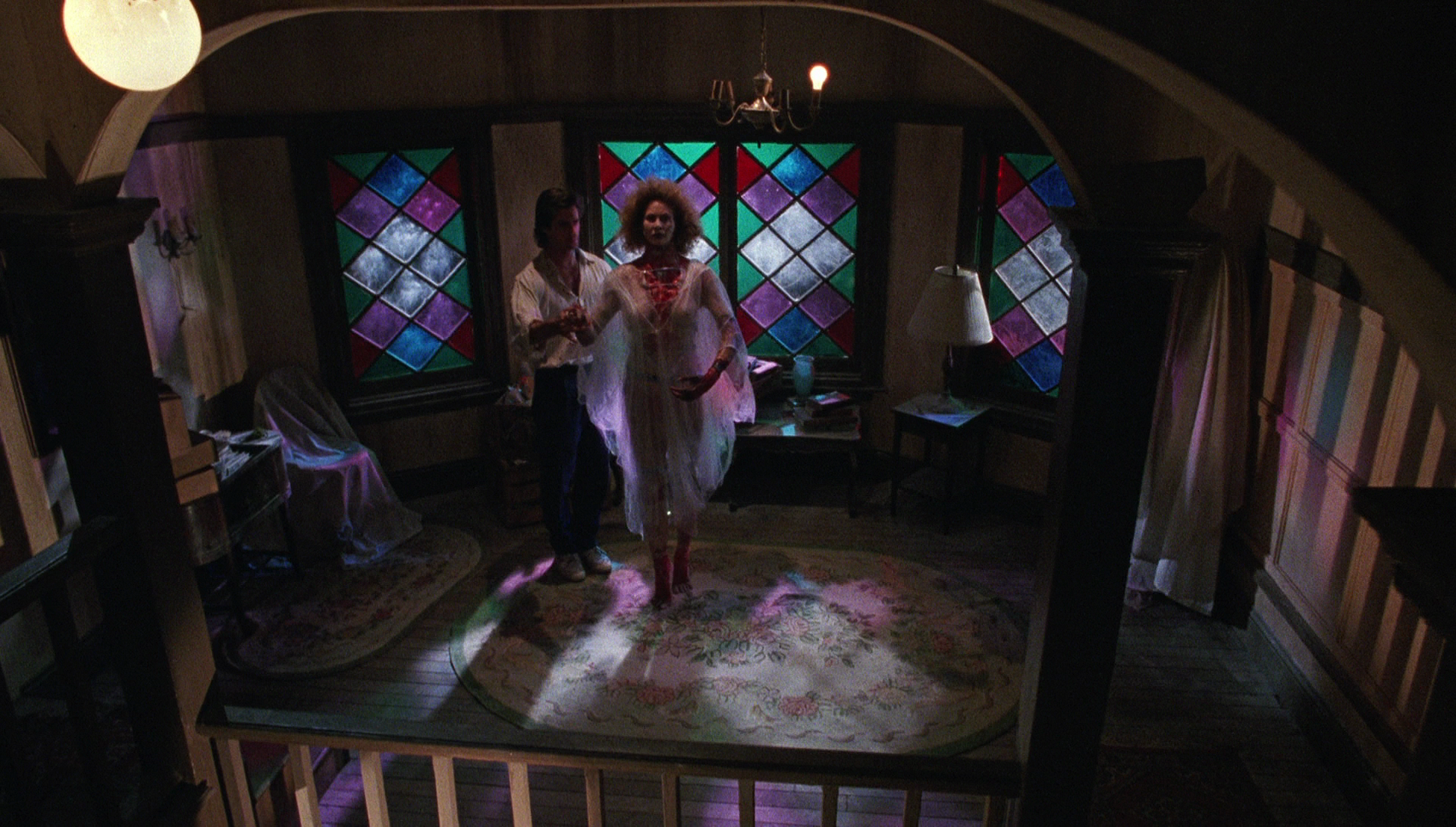 Though it’s often derided in relation to Stuart Gordon’s Re-Animator, I’ve always felt that Bride of Re-Animator was just as interesting as its predecessor (to the extent that I have an original one sheet poster for the film, which until my children were born was displayed in my hallway). It’s a film with many delicious moments of black comedy: responding to Chapham’s discovery of the composite corpse of the ‘bride’ (‘You butcher!’, Chapham exclaims), West responds by simply asserting, ‘How dare you judge my work?’ When Hill is reanimated by Dr Graves, Hill initiates a conversation by telling Graves ‘I recognise you’. A shocked and happy Graves asks, ‘You do?’ ‘That seminar in Zurich…’, Hill continues. ‘Yes?’, Graves asks excitedly. ‘Your theory of reconciling creationism with the origin of disease…’, Hill says. ‘Yes?’, Graves asks, his anticipation of praise from the ‘great’ Dr Hill growing. ‘Totally idiotic!’, Hill bellows. Though it’s often derided in relation to Stuart Gordon’s Re-Animator, I’ve always felt that Bride of Re-Animator was just as interesting as its predecessor (to the extent that I have an original one sheet poster for the film, which until my children were born was displayed in my hallway). It’s a film with many delicious moments of black comedy: responding to Chapham’s discovery of the composite corpse of the ‘bride’ (‘You butcher!’, Chapham exclaims), West responds by simply asserting, ‘How dare you judge my work?’ When Hill is reanimated by Dr Graves, Hill initiates a conversation by telling Graves ‘I recognise you’. A shocked and happy Graves asks, ‘You do?’ ‘That seminar in Zurich…’, Hill continues. ‘Yes?’, Graves asks excitedly. ‘Your theory of reconciling creationism with the origin of disease…’, Hill says. ‘Yes?’, Graves asks, his anticipation of praise from the ‘great’ Dr Hill growing. ‘Totally idiotic!’, Hill bellows.
Arrow’s new Blu-ray release of Bride of Re-Animator contains an exemplary presentation of the film. Though the release includes both the unrated and ‘R’ rated versions of the picture, the ‘R’ rated cut is little more than a curiosity and most viewers will find themselves defaulting to the unrated version of the film – which, considering the ‘body horror’ focus, offers a more meaty experience, if you’ll pardon the pun. Arrow’s presentations of both cuts are very good, and this release contains some excellent contextual material, both old and new. The new commentary from Yuzna is definitely worth a listen, and the new interviews and featurettes are very good too. Fans of the film will find this release to be an essential purchase. References: Fischer, Dennis, 2000: Science Fiction Directors, 1895-1998. North Carolina: McFarland & Company, Inc Newitz, Annalee, 2006: Pretend We’re Dead: Capitalist Monsters in American Pop Culture. Duke University Press Towlson, Jon, 2014: Subversive Horror Cinema: Countercultural Messages of Films from “Frankenstein” to the Present. London: McFarland & Company Visual comparison with the German Blu-ray release from Capelight. Arrow’s new Blu-ray (2016): 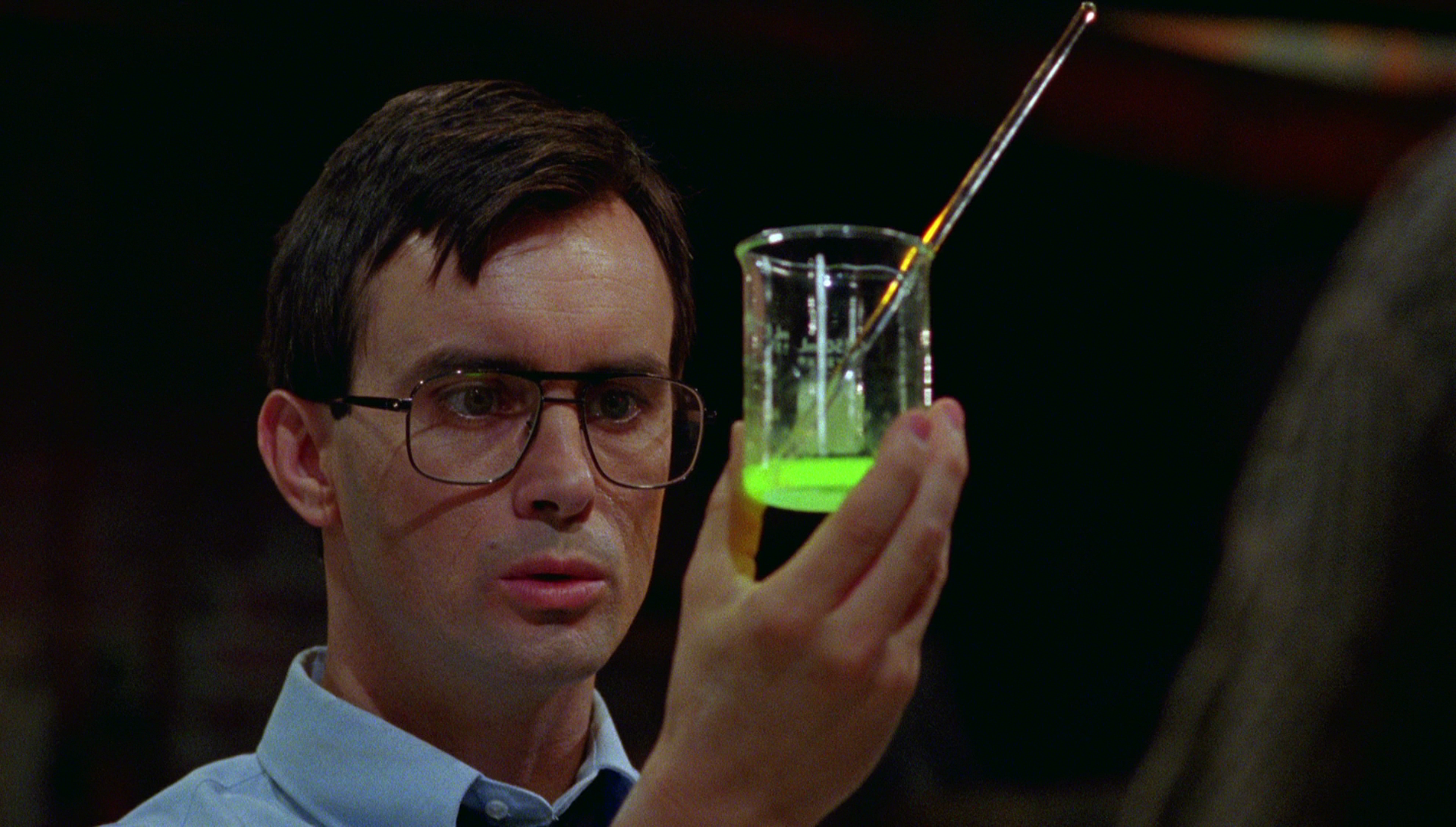
Capelight’s Blu-ray (2014): 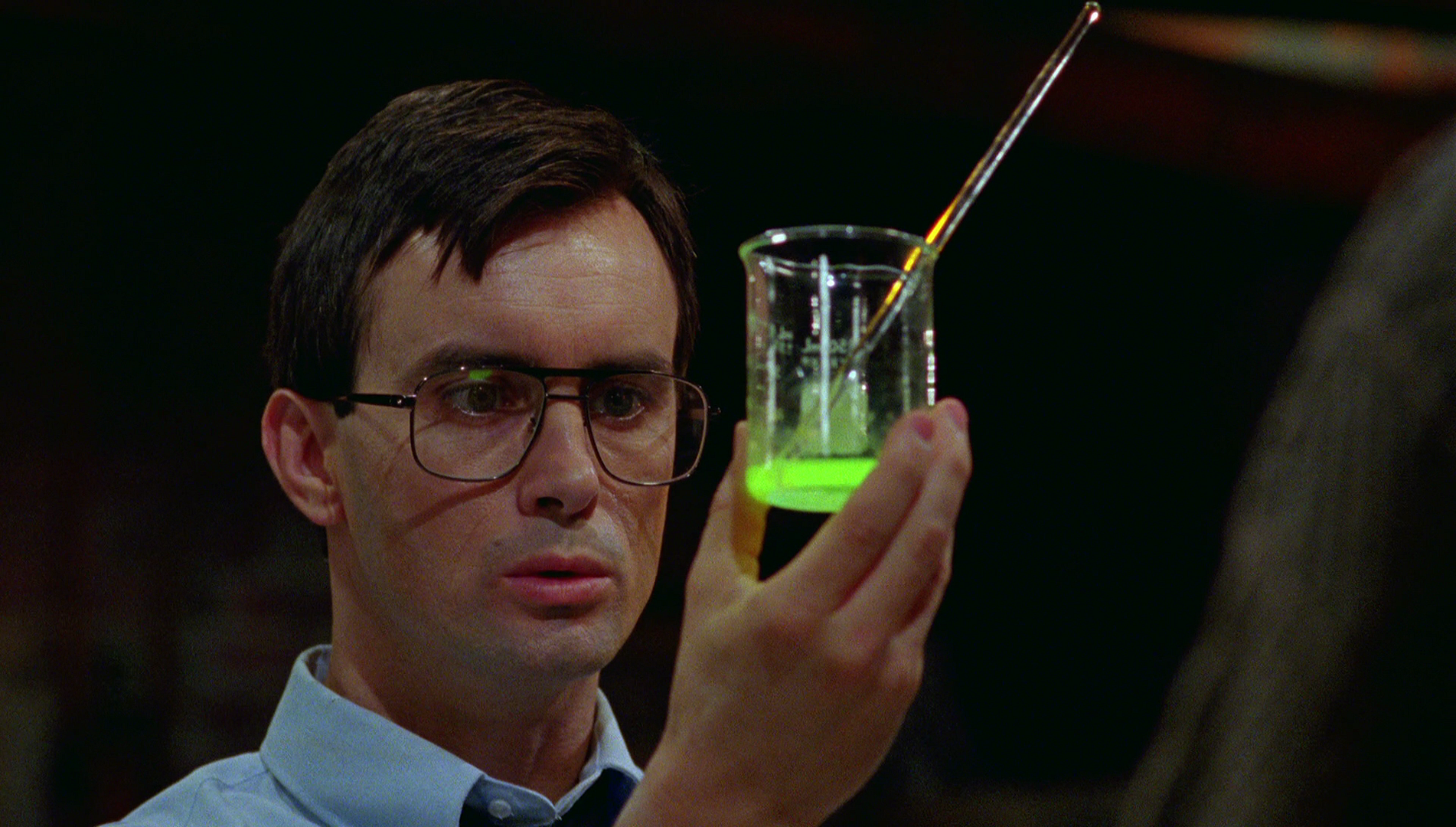
Arrow’s new Blu-ray (2016): 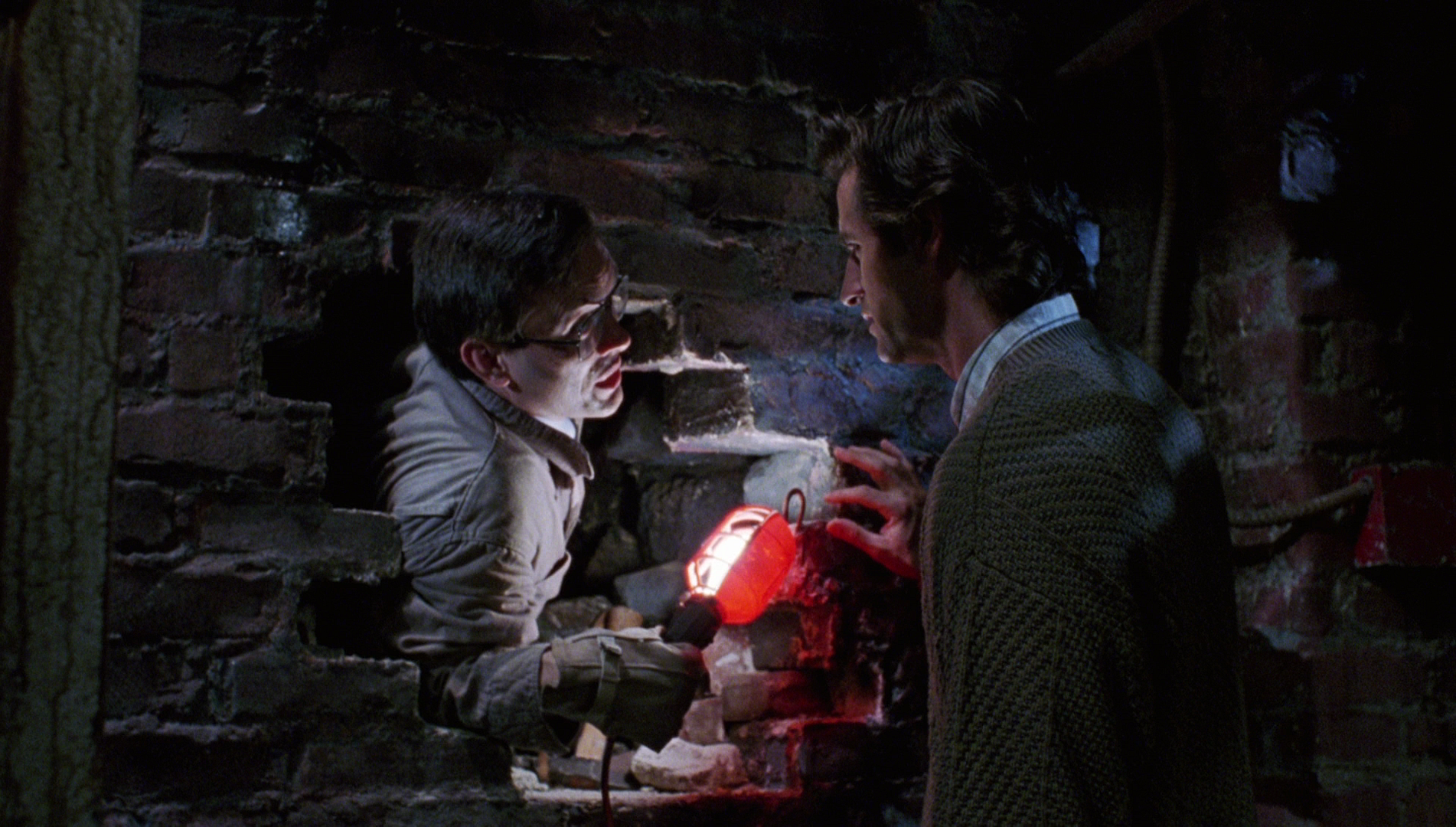
Capelight’s Blu-ray (2014): 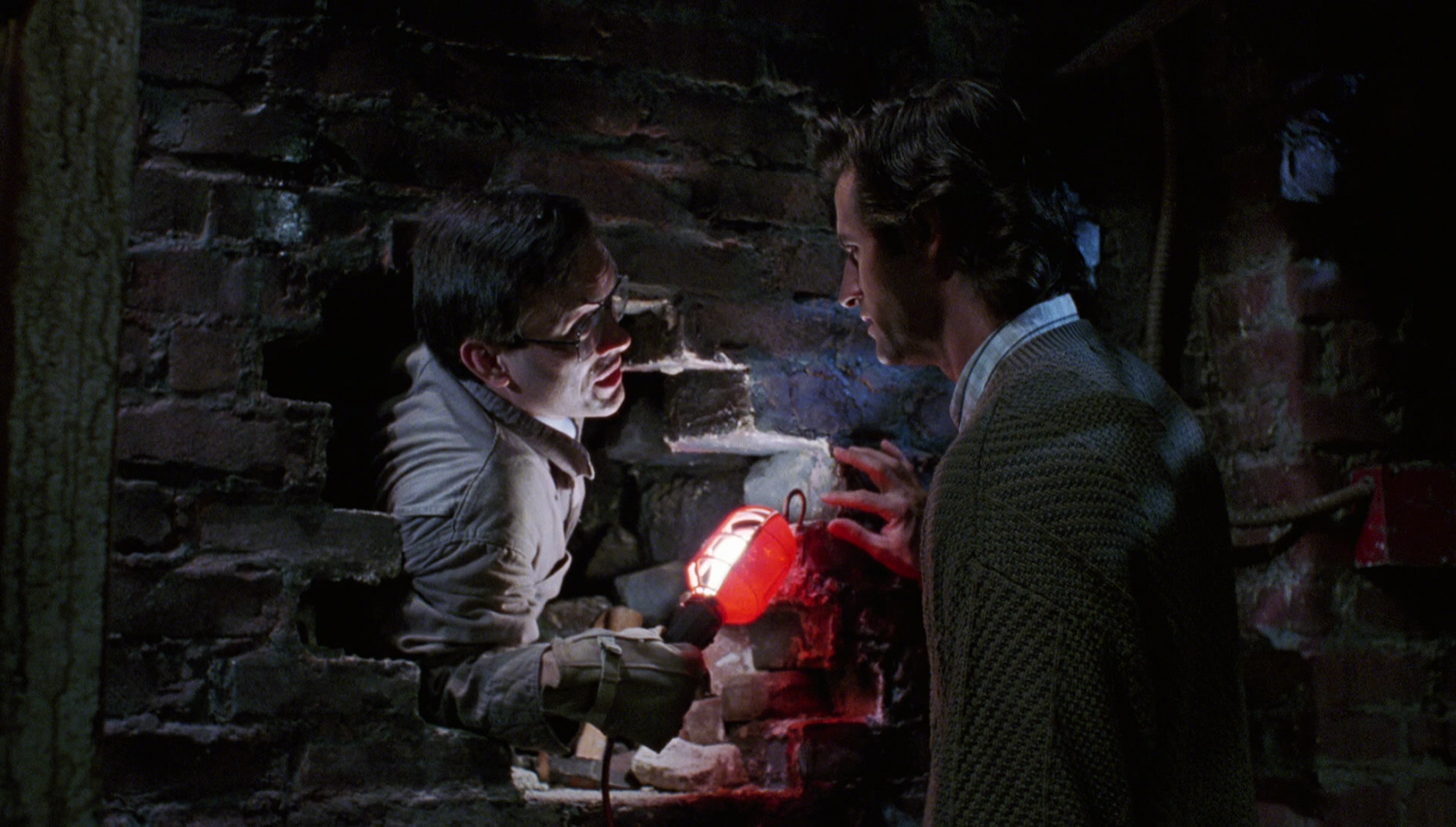
Arrow’s new Blu-ray (2016): 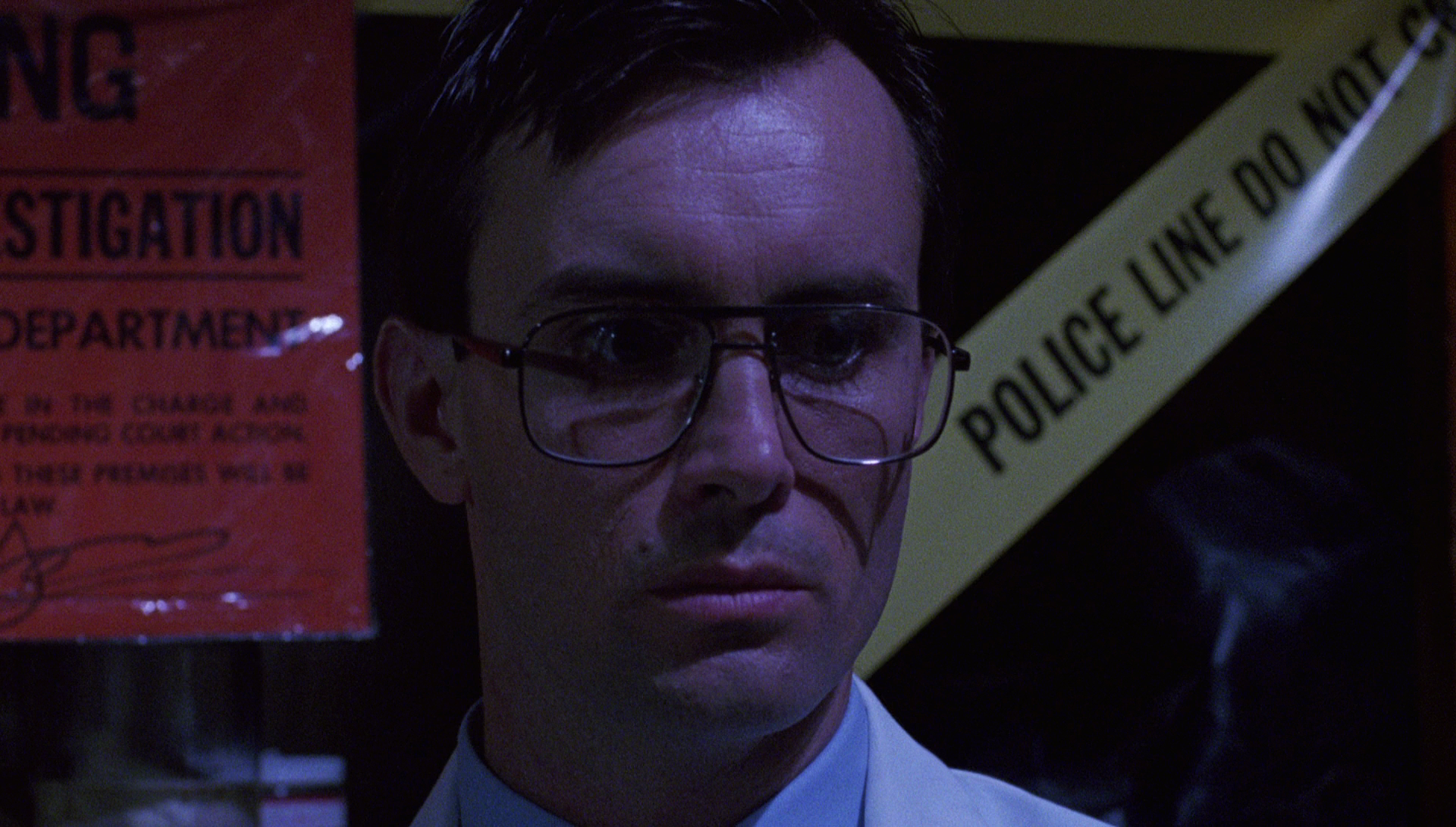
Capelight’s Blu-ray (2014): 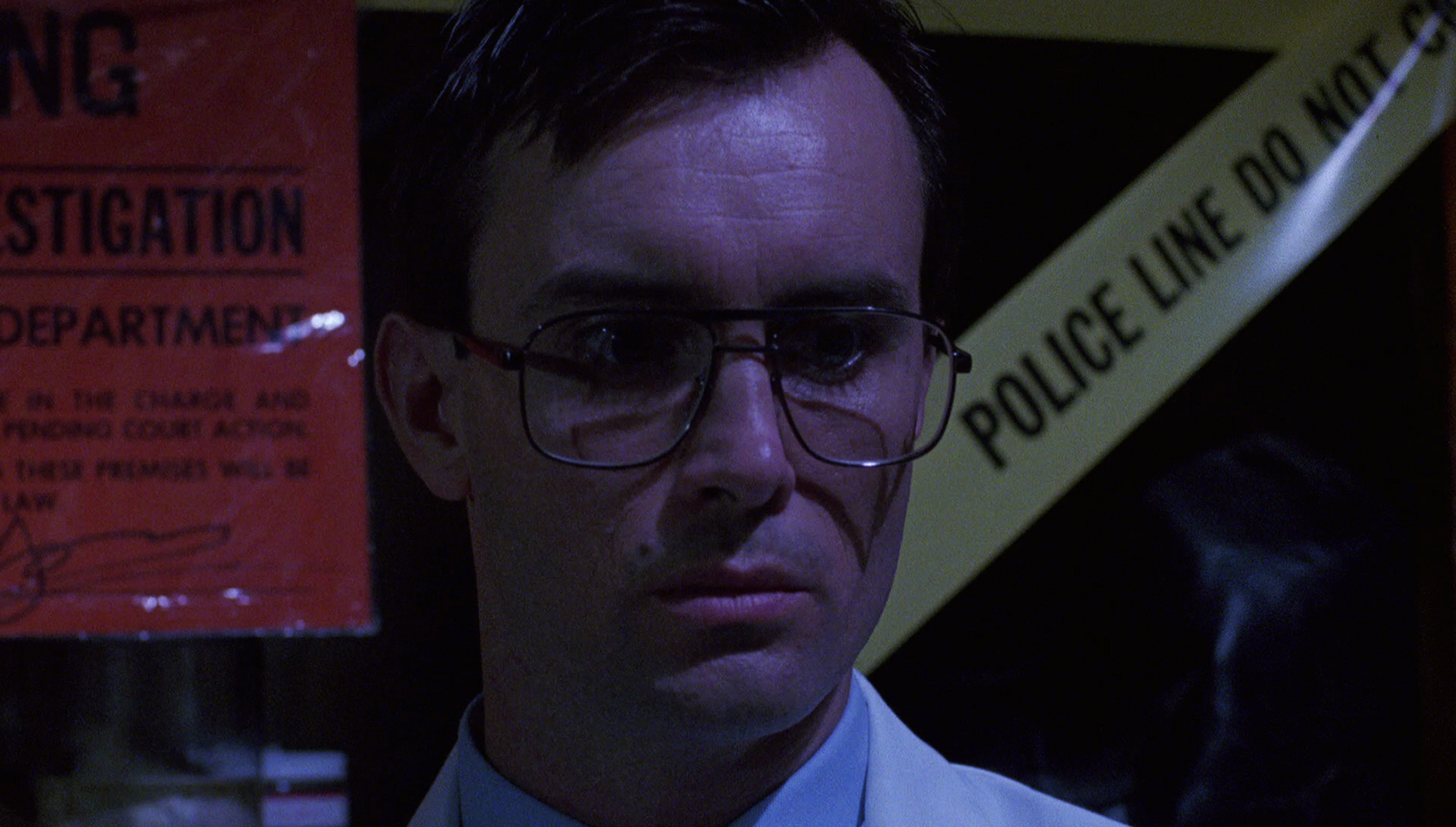
Arrow’s new Blu-ray (2016): 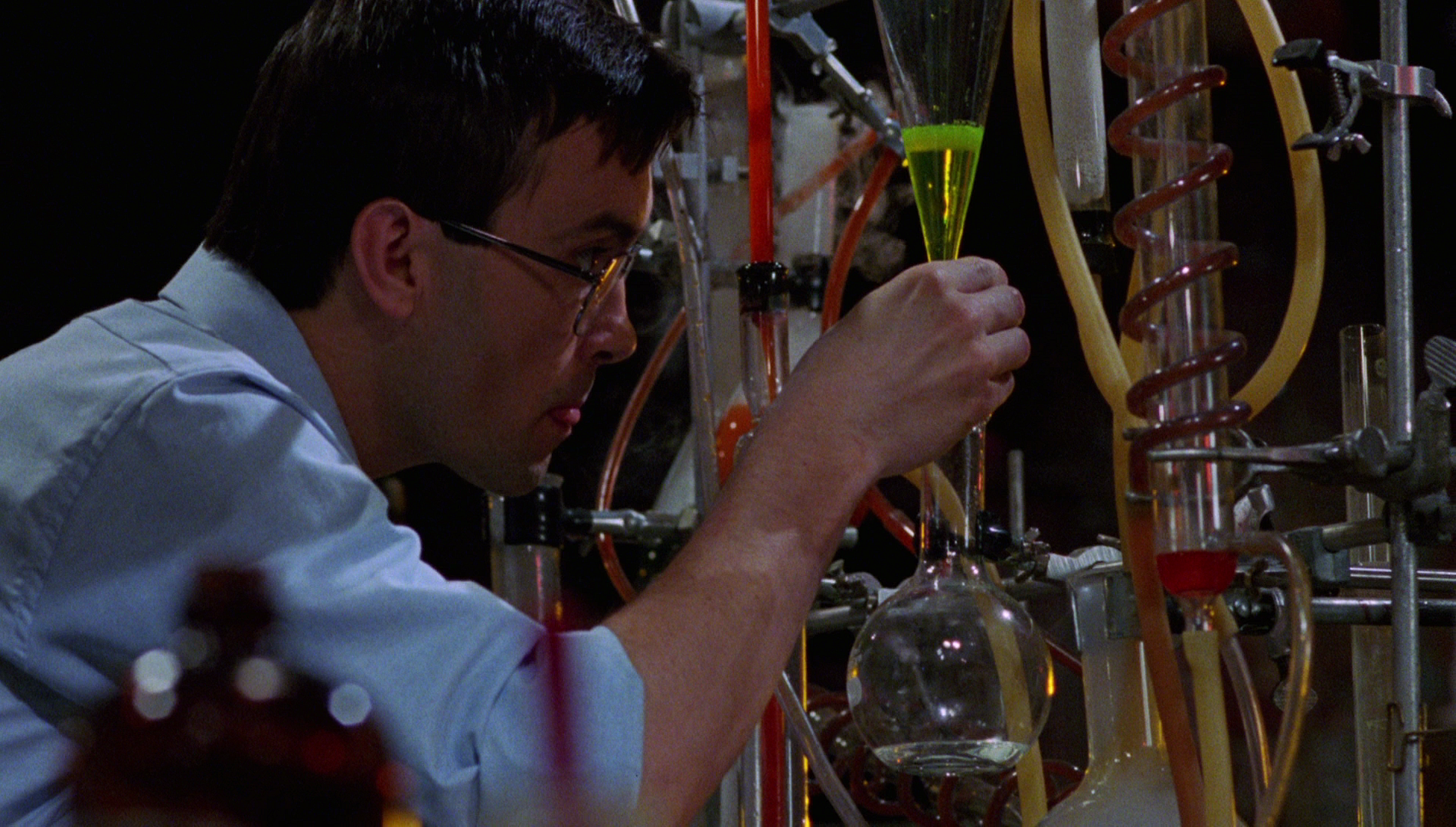
Capelight’s Blu-ray (2014): 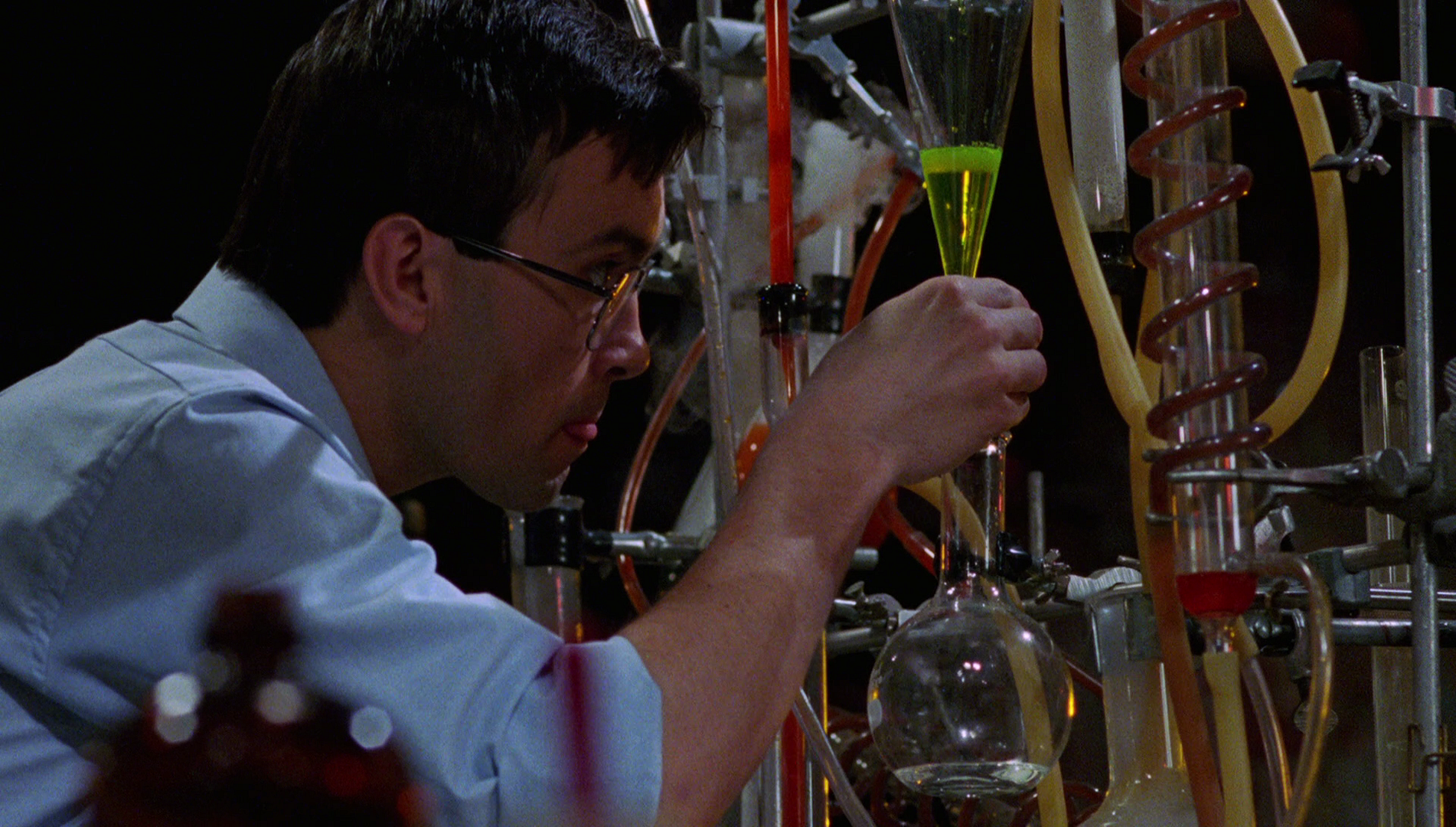
Arrow’s new Blu-ray (2016): 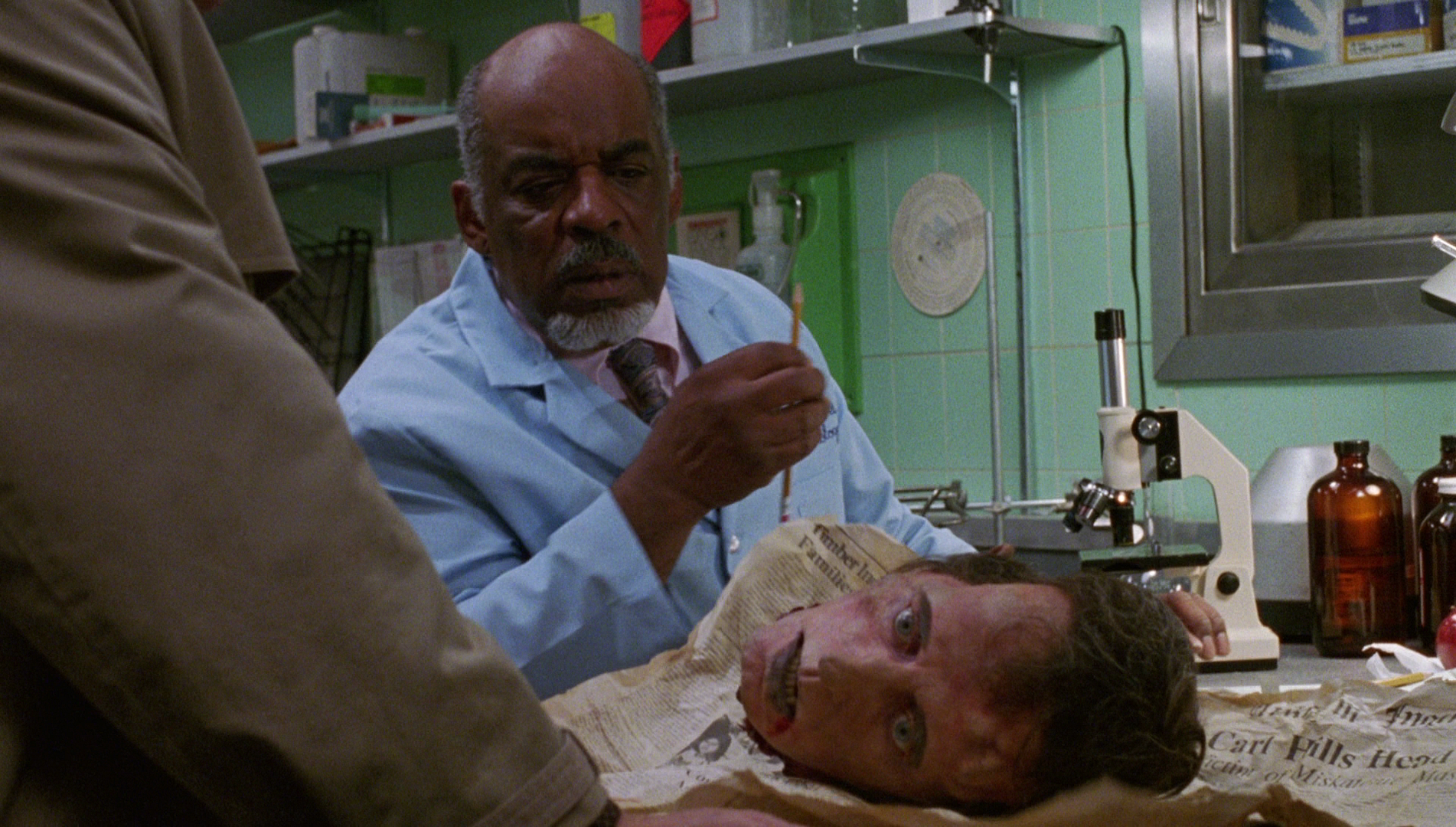
Capelight’s Blu-ray (2014): 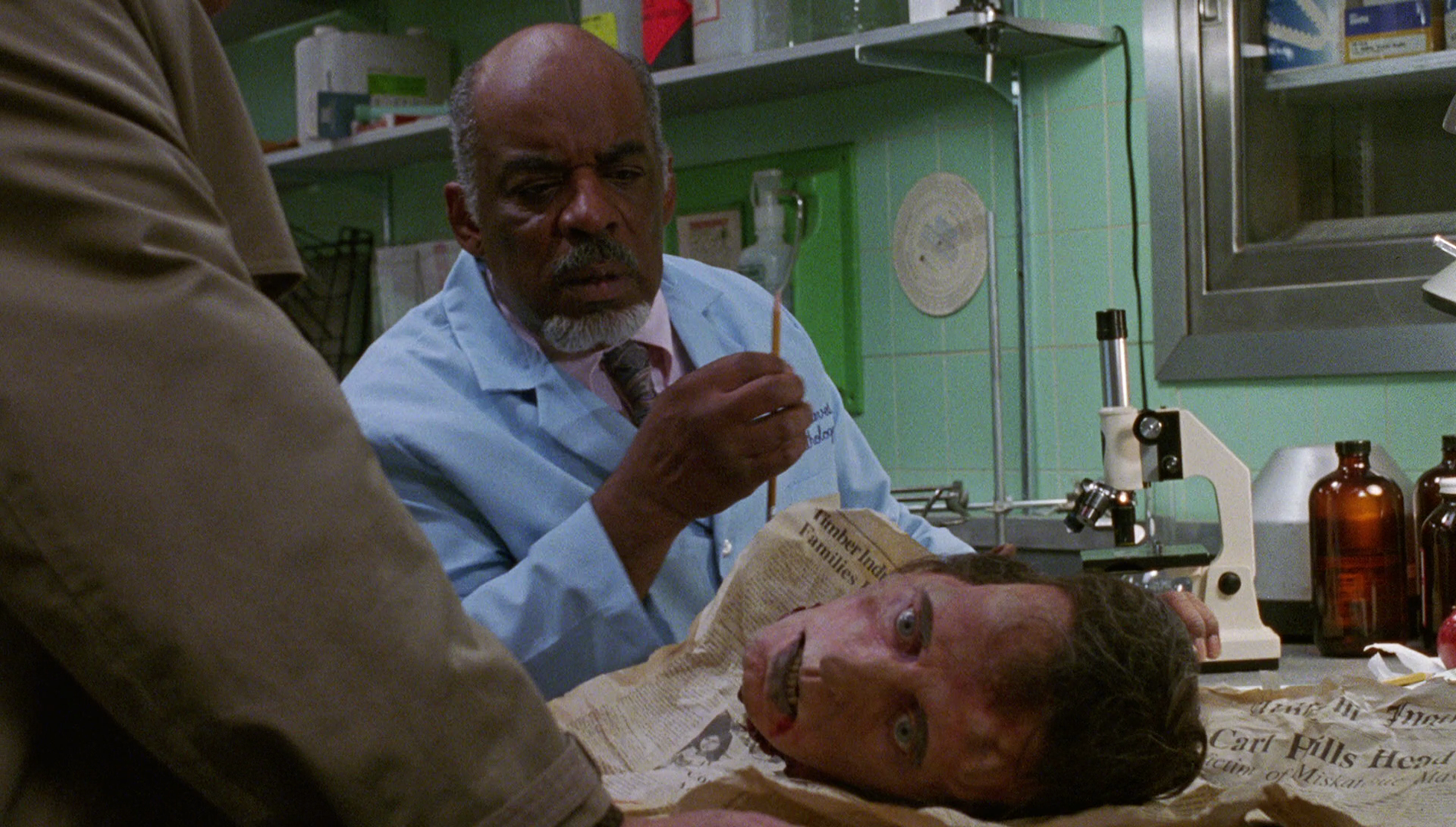
More screen grabs from Arrow’s new Blu-ray presentation: 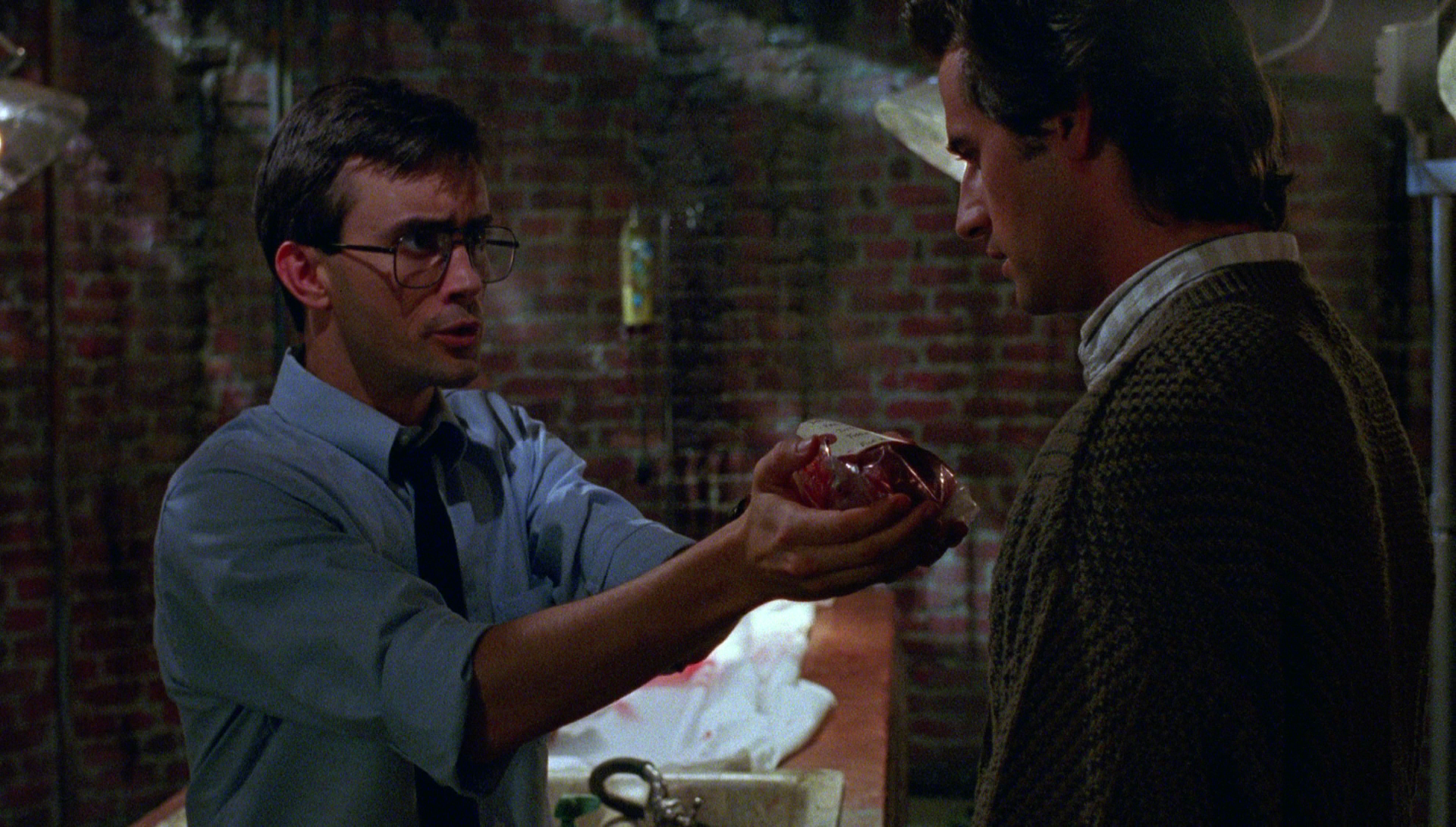
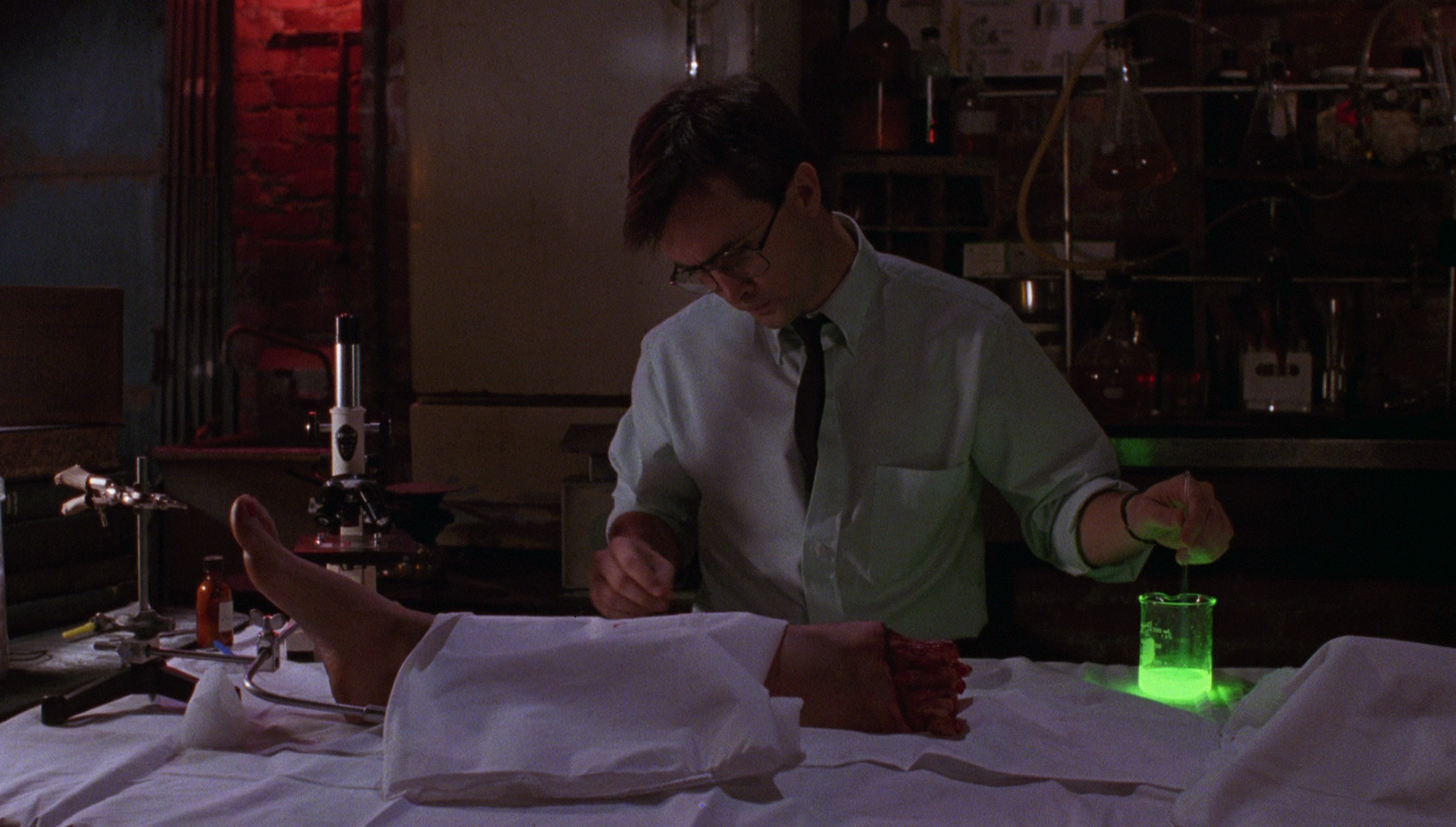
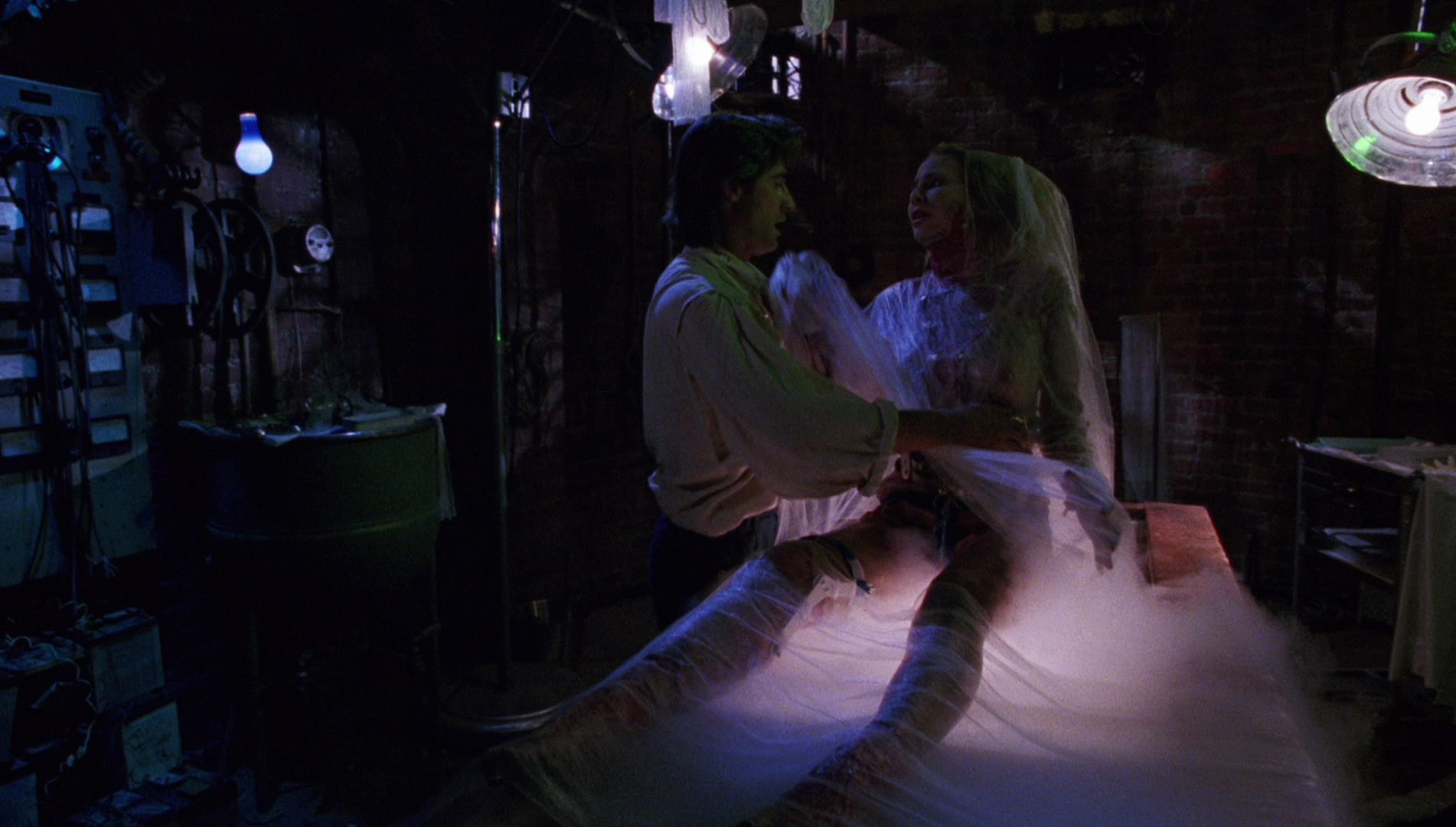
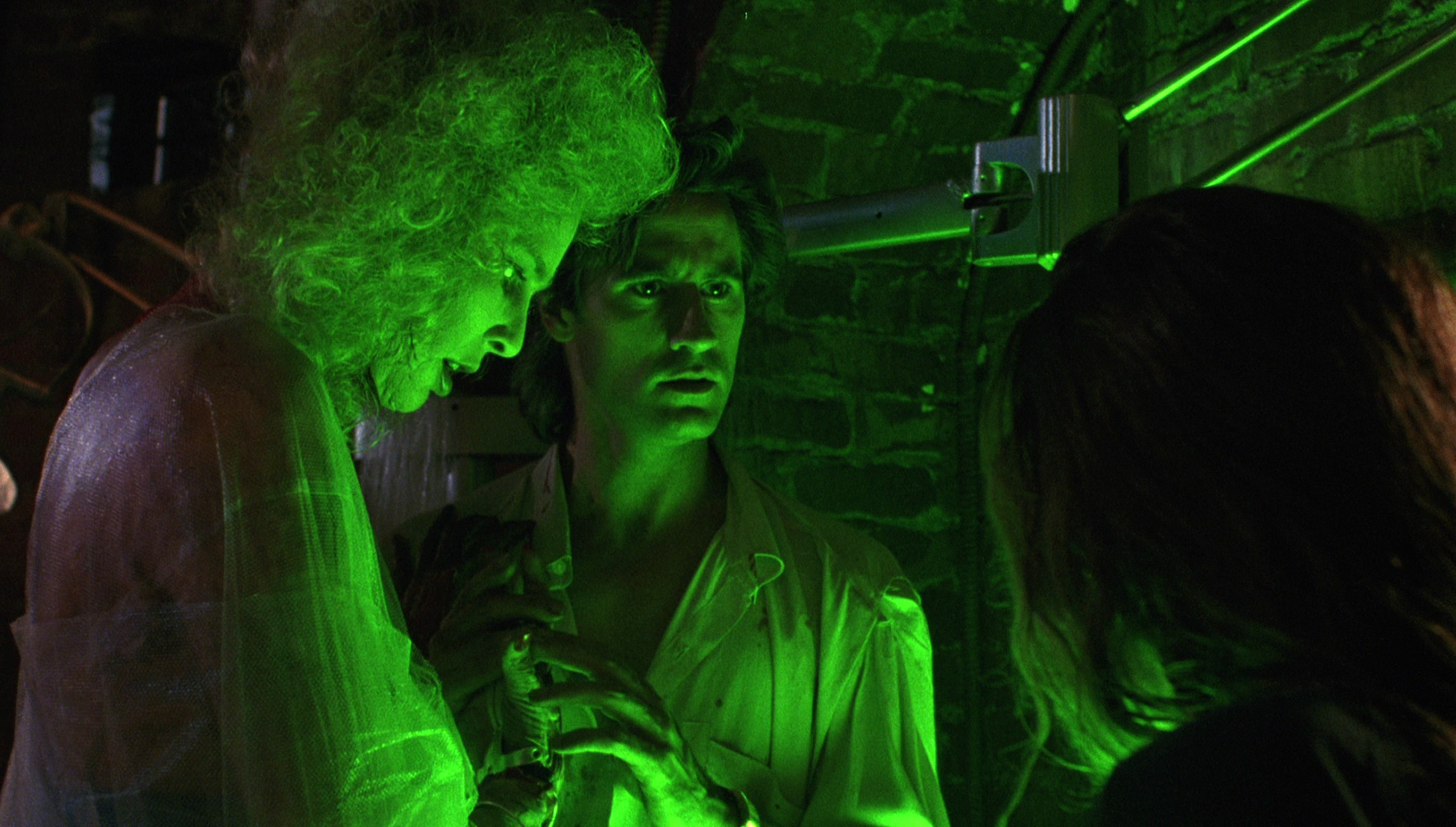
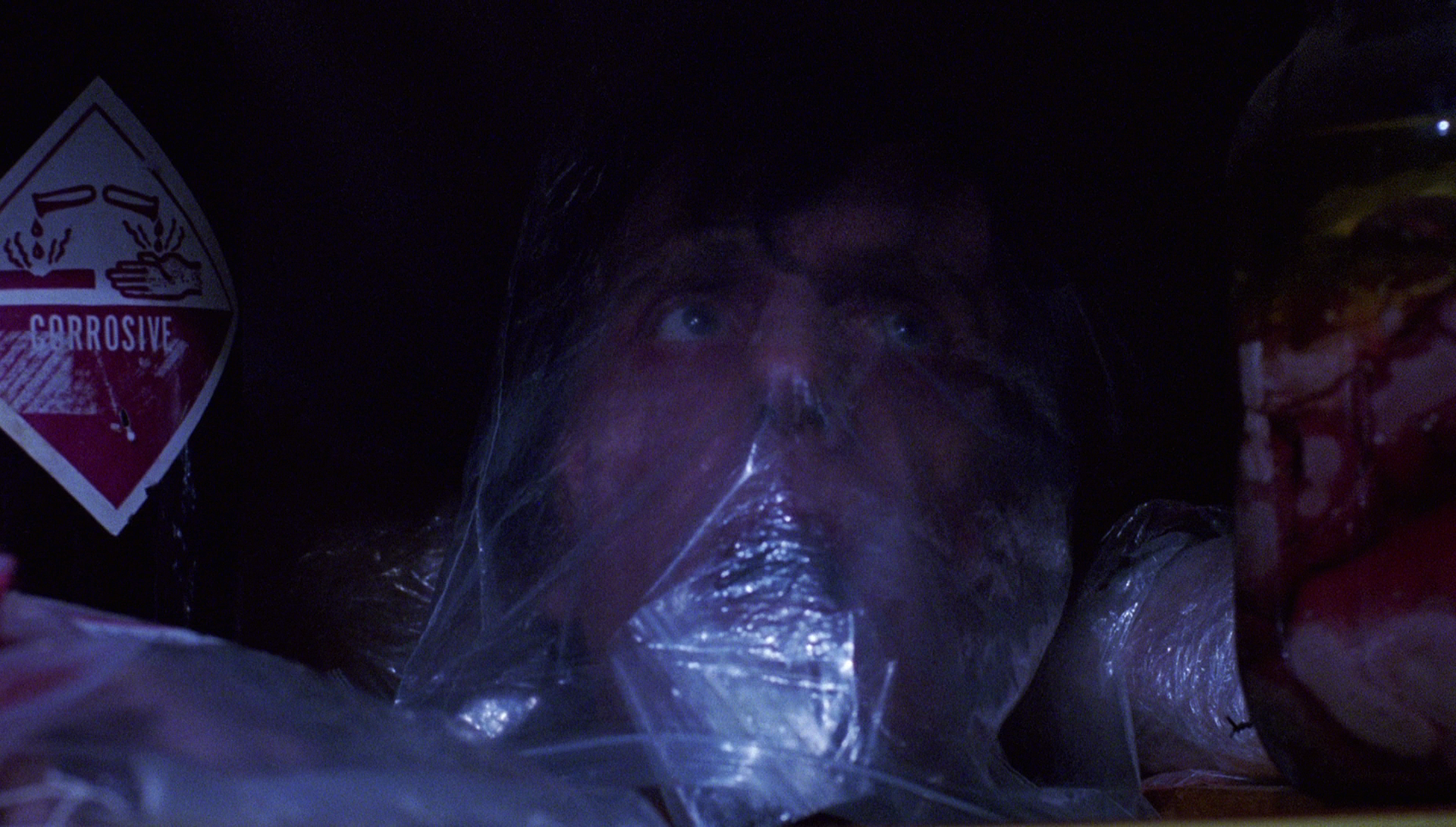

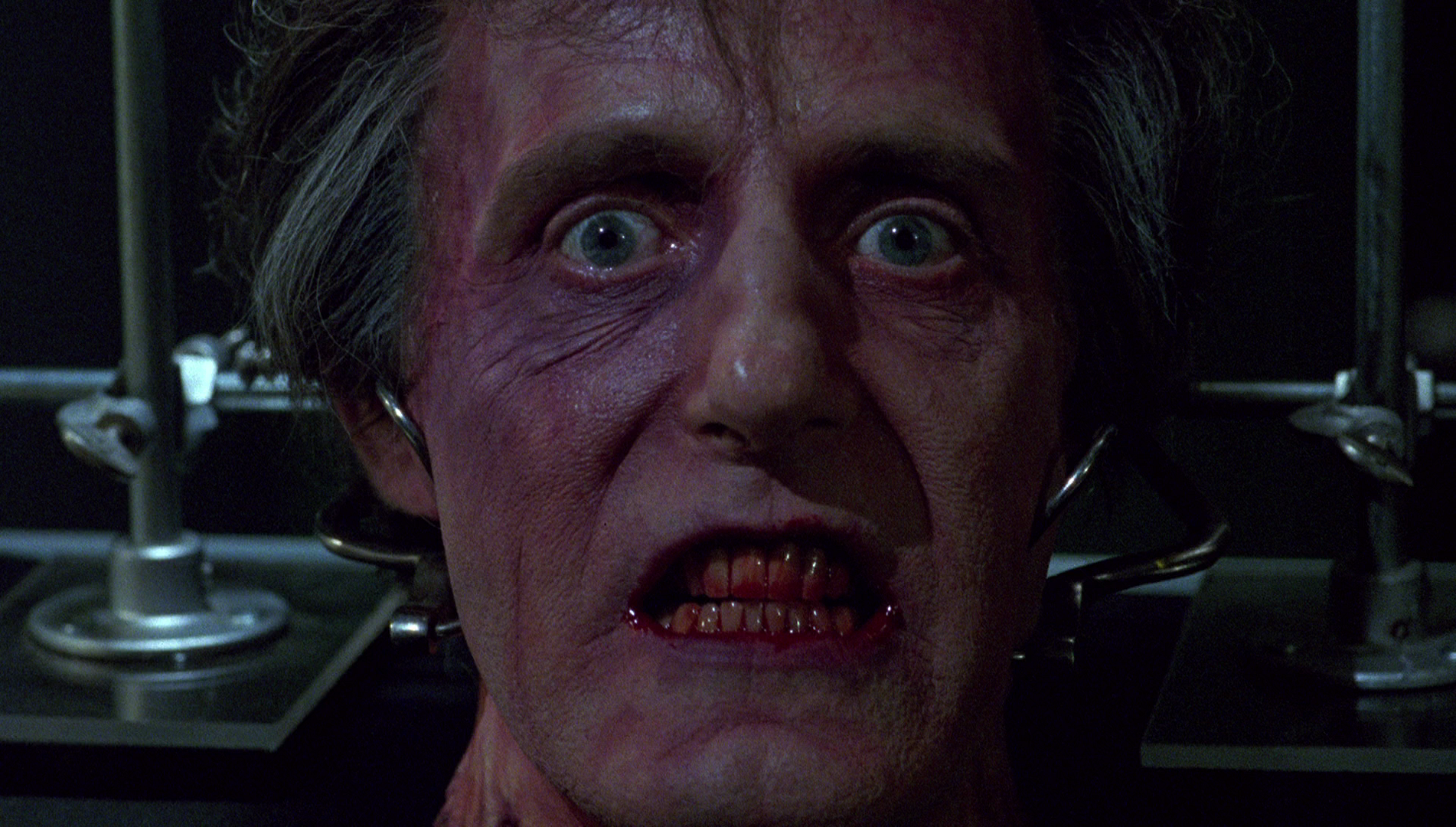
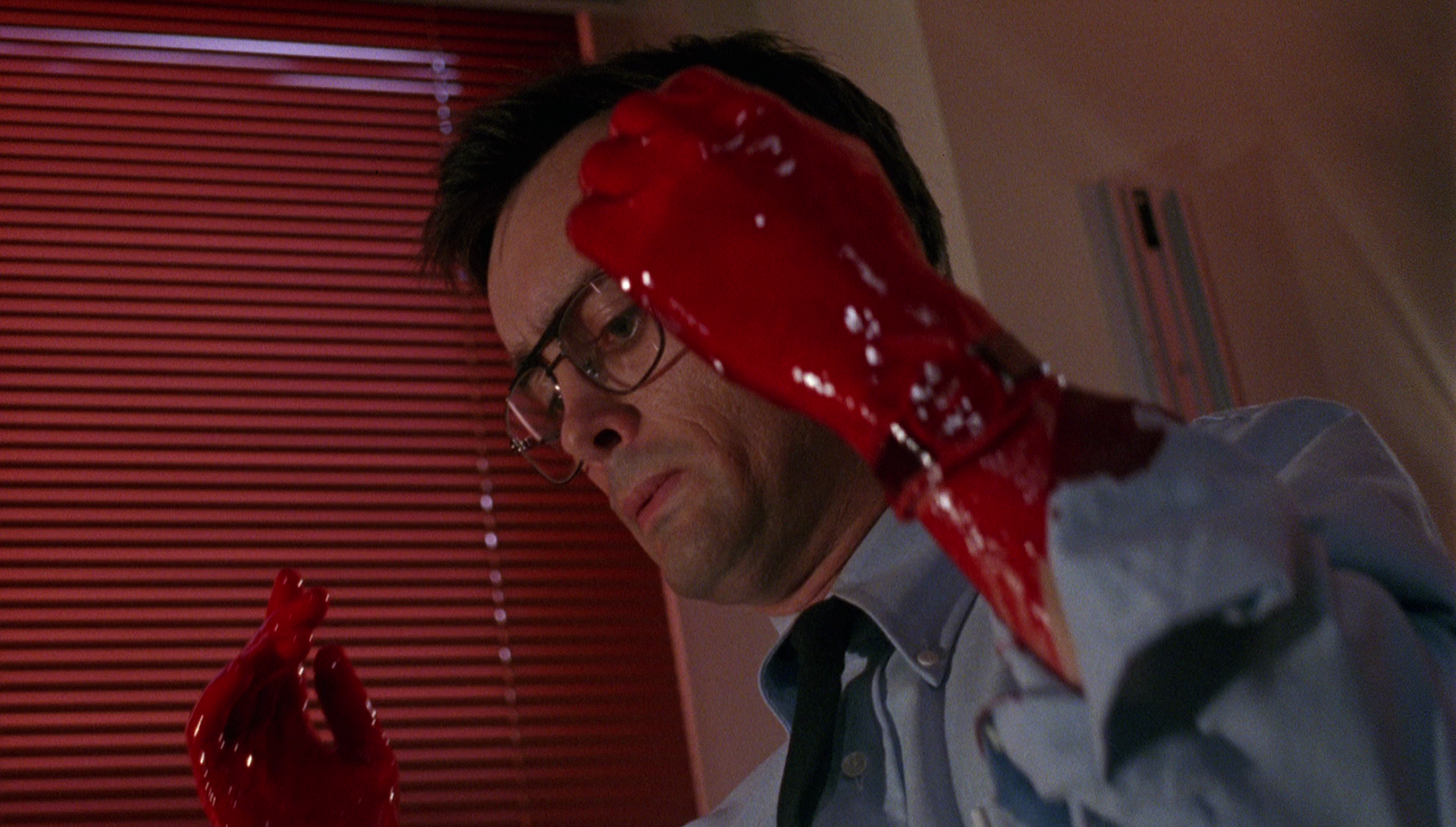
|
|||||

|